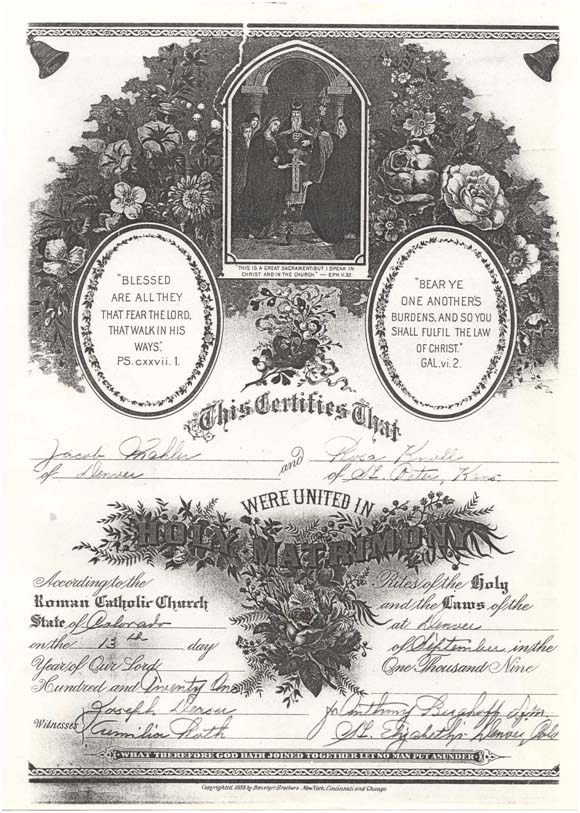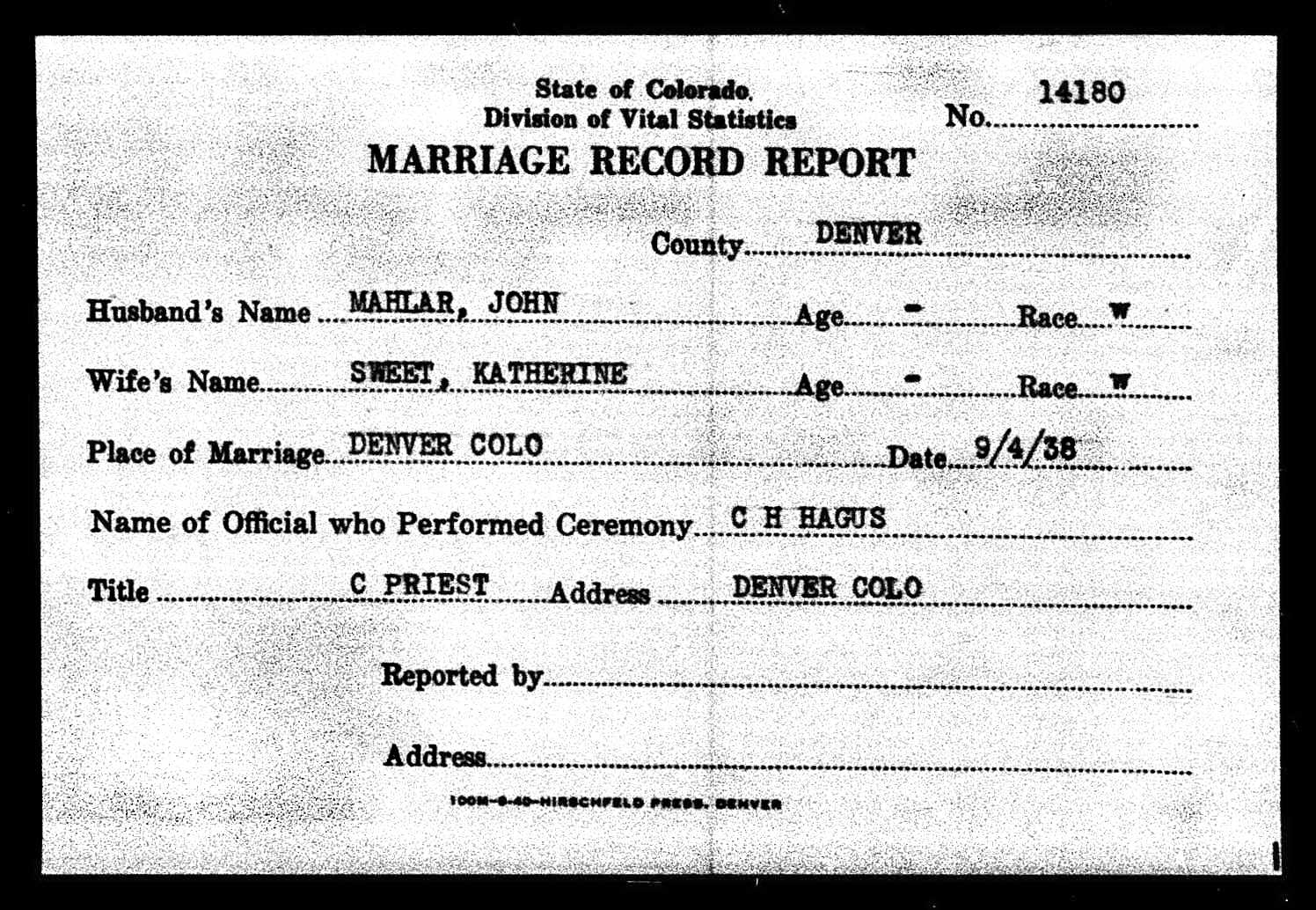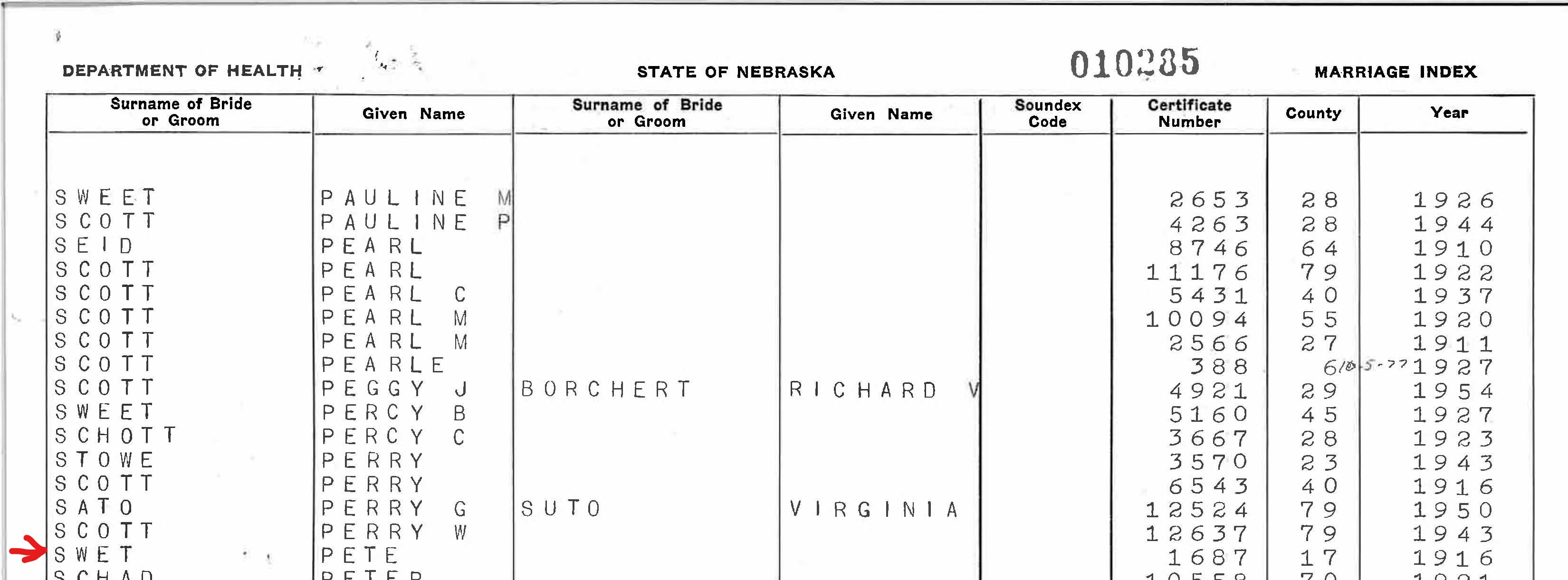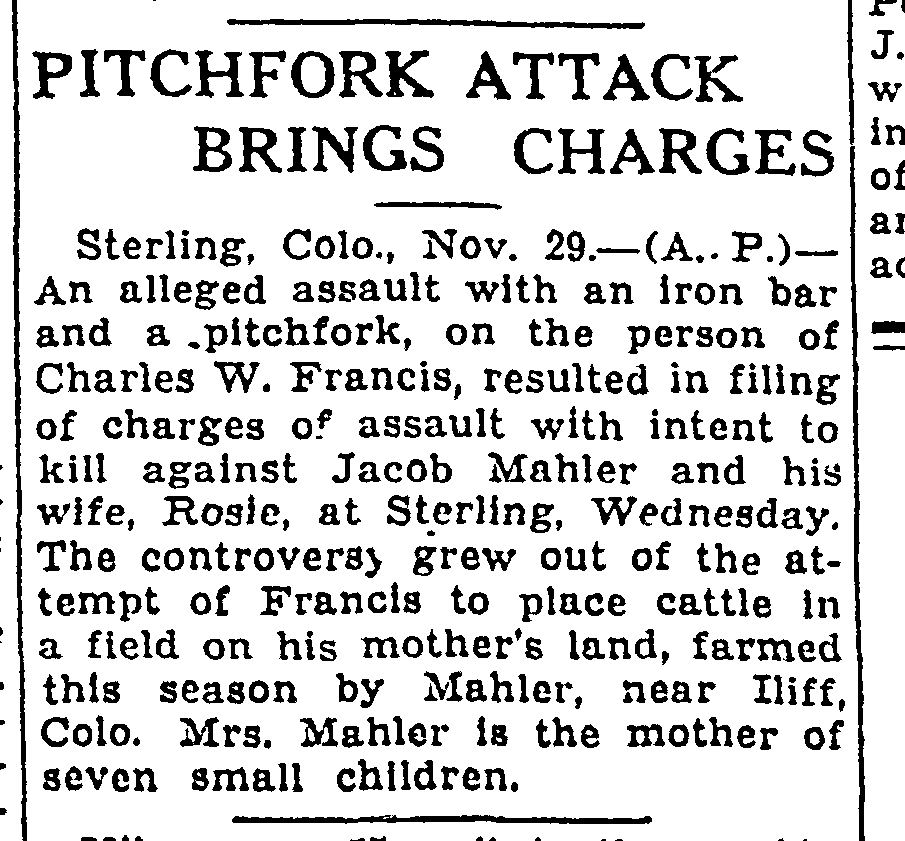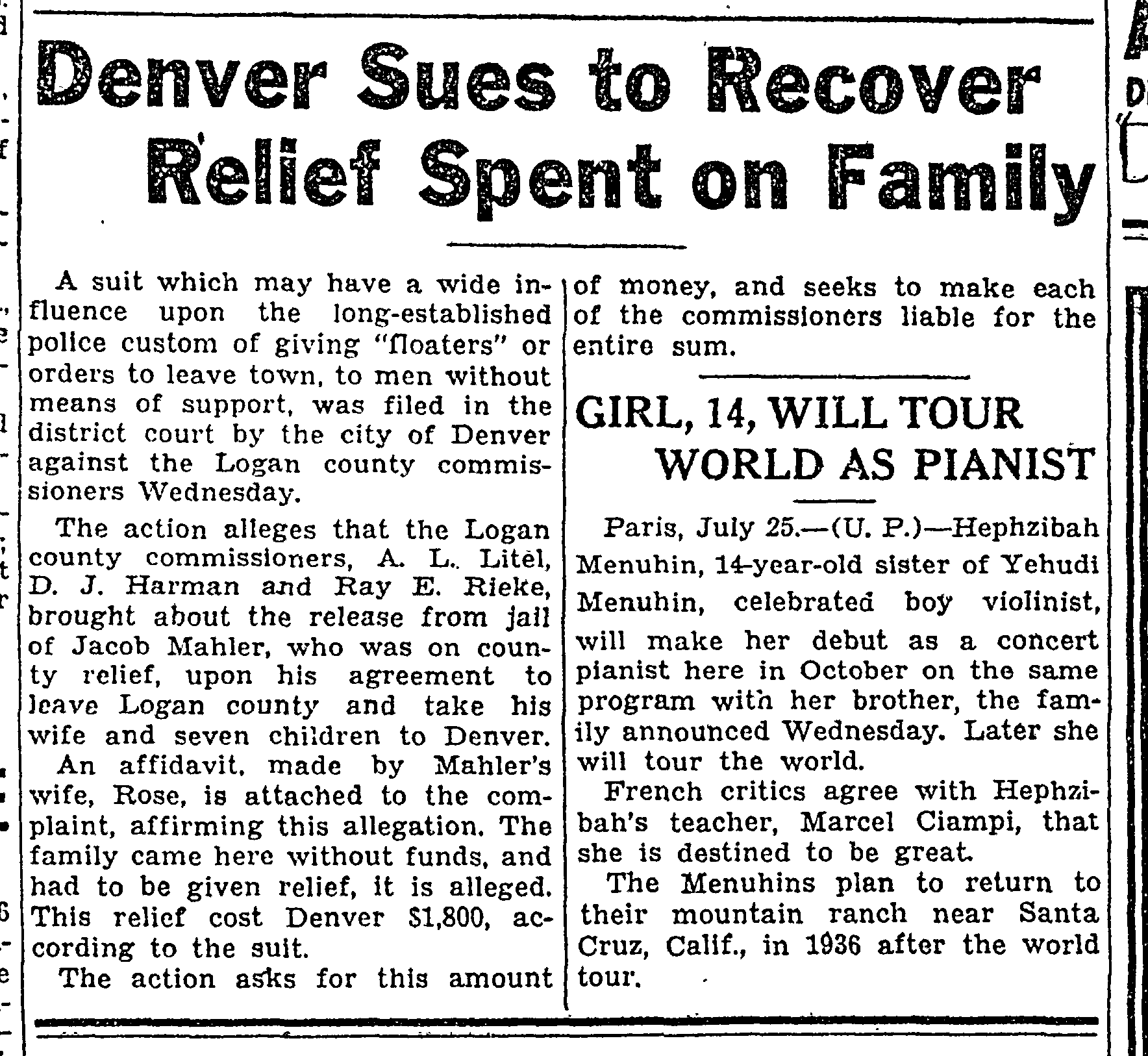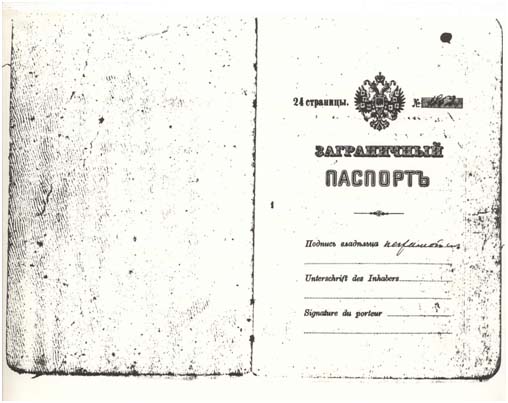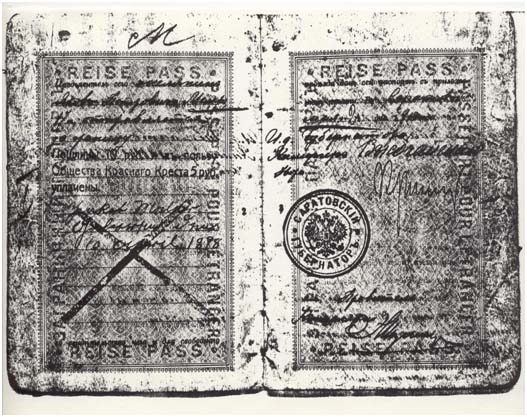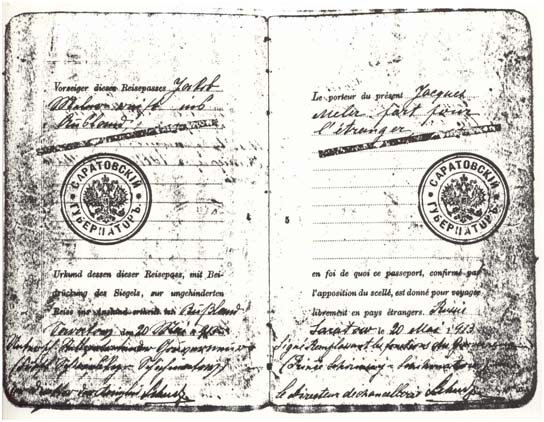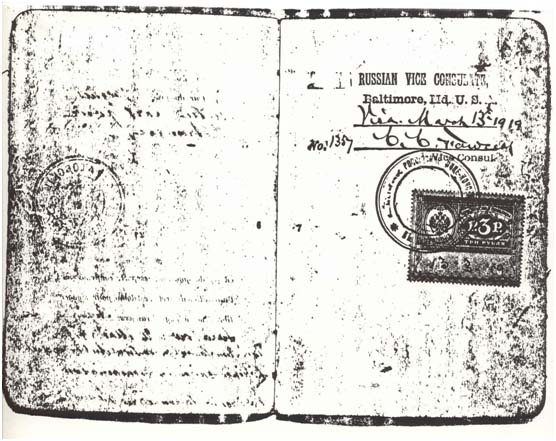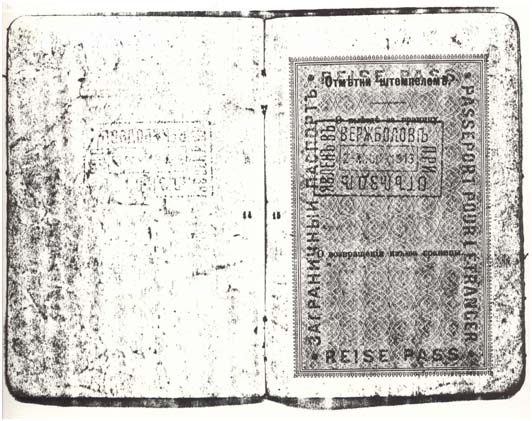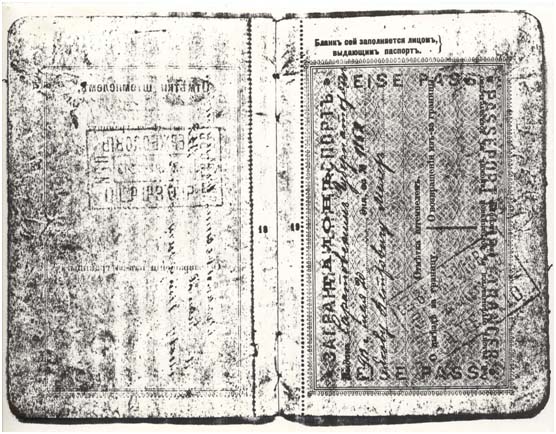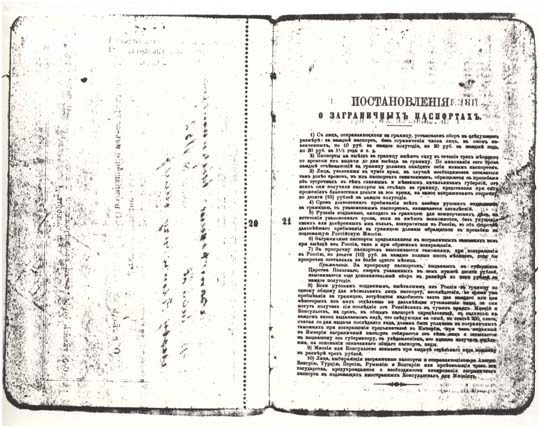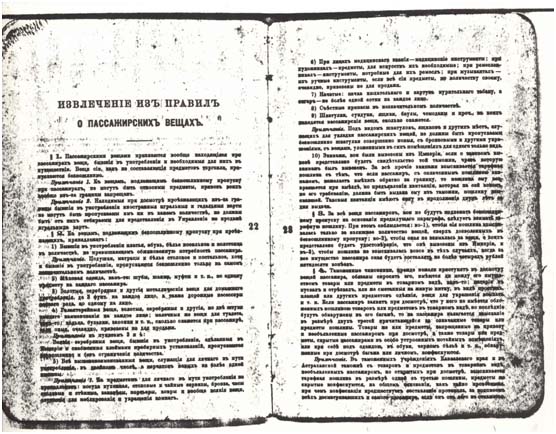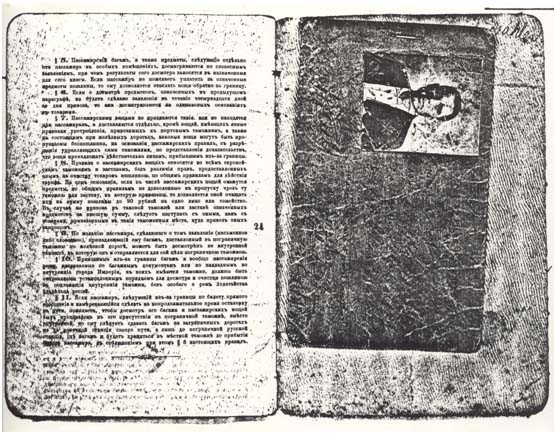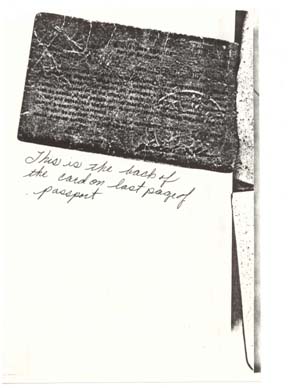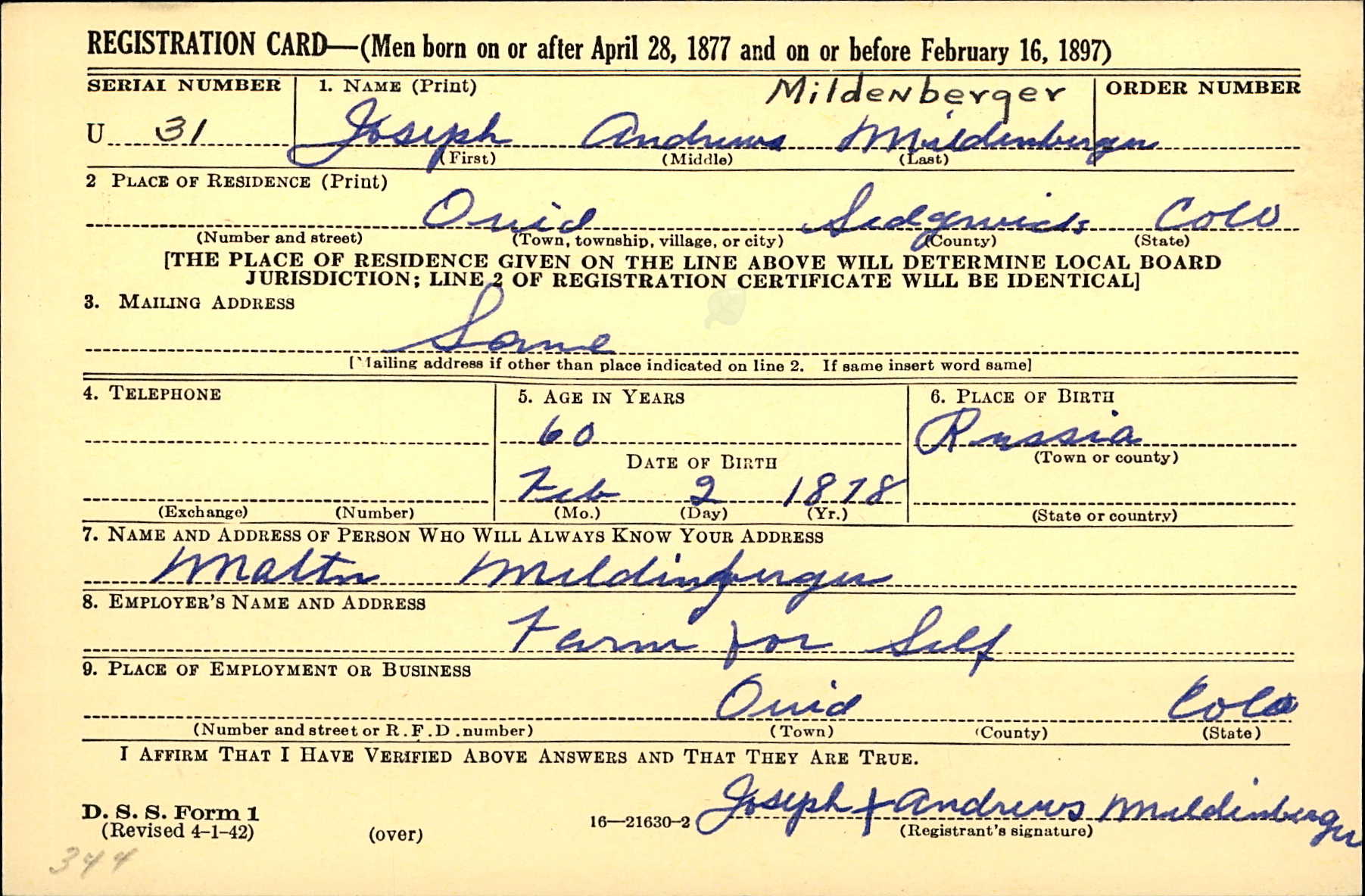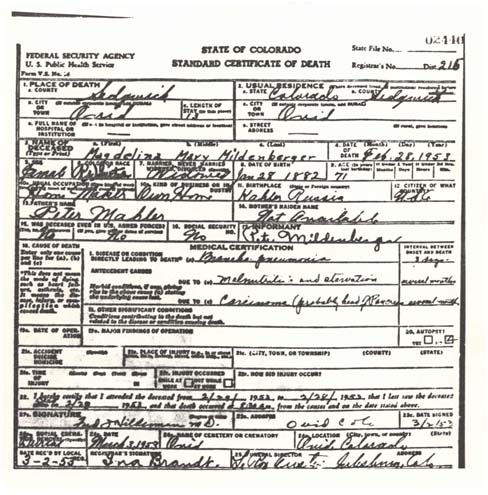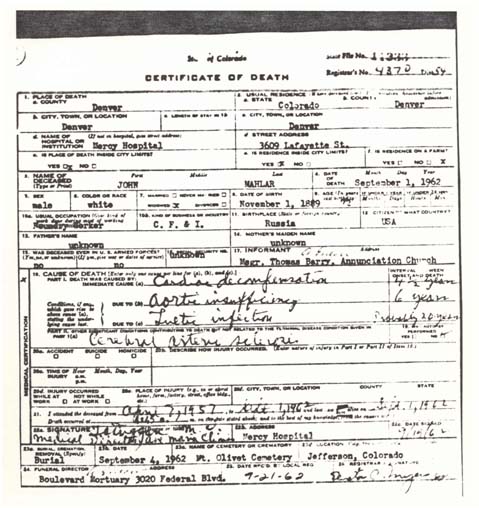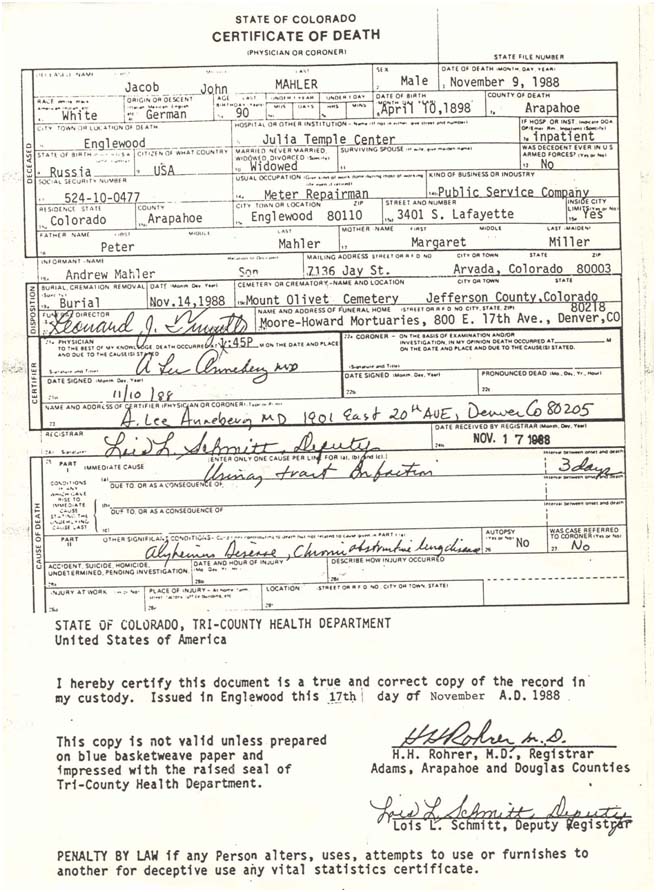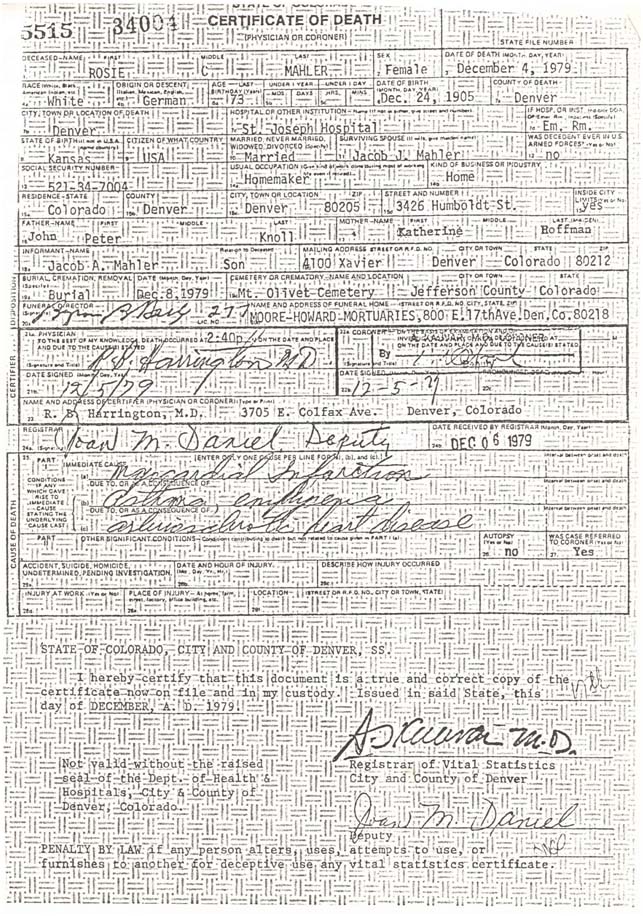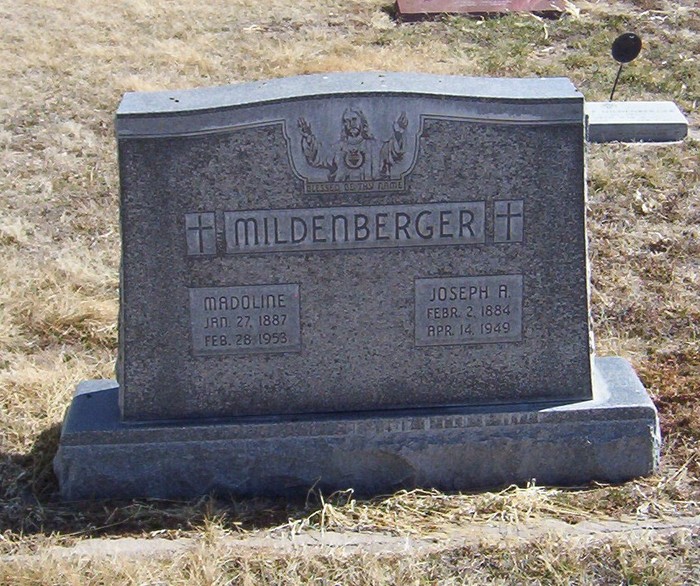Citing this biography: Boyd, Michelle, "Peter Mehler and Margaretha Müller," article, Olive and Eliza, last accessed [current date]."
Peter Mehler was born 15 October 1855 in Leichtling, Saratov,
Russia to Johannes Mehler and
Elisabetha Schäfer. He was christened the same day in
Köhler, Saratov, Russia.
Peter married first Margaretha Nahm (born about 1853 to Matthias
Nahm and Katharina Schtremel, from Leichtling) 6 November 1873 in
Köhler, Saratov, Russia. Peter married second Margretha Müller
29 January 1880 in Köhler, Saratov, Russia. Margaretha was born 27
September 1858 "at night" in Leichtling, Saratov, Russia to Johannes
Müller and Elisabeth Berger. She was christened 28 September
1858 in Köhler, Saratov, Russia.
Peter and Margaretha sent two of their sons, John and Jacob, to America
and a daughter, Magdalina, also immigrated. The couple was living in
Kohler, Saratov, Russia when their daughter Magdalina immigrated in
1913. They, along with their youngest daughter Barbara and her husband,
were living in Leichtling when the Communist Revolution took place and
Russia became the Soviet Union.
Their son Jacob sent them money so they could likewise immigrate to
America. The part of the family still in Russia attempted to leave but
were stopped at the Russian border and their money was taken from them.
Peter was shot to death in 1920 on the steps of the Catholic church in
Leichtling, Saratov, Russia by Bolsheviks. Margret died of starvation in
1934 in Leichtling, Saratov, Russia.
Because of the secrecy of the Soviet government, letters going to
America were heavily censored with anything objectionable blacked out.
The Germans in Russia sent news that could potentially be censured to
their relatives in America by writing it on the envelope instead of the
letter and covering it with the stamp. The recipient would then steam
off the stamp and read the real news. Their son Jacob, who had been
working with the Red Cross to try and get his family out of the USSR,
are said to have learned of their parents’ deaths in this manner.
Peter and Margaretha (Nahm)’s children are:
| 1 | Anna
Meller, born 23 Aug 1874 in Leichtling, Saratov, Russia,
baptized 24 Aug 1874 in Köhler, Saratov, Russia. |
Peter and Margaretha (Müller)’s children are:
| 2 | Sophia
Meller, born 31 May 1881 in Leichtling, Saratov, Russia,
baptized the same day in Köhler, Saratov, Russia. |
| 3 | Magdelina Mary Mehler,
born 2 Feb 1884 in Leichtling, Saratov, Russia, baptized the same
day in Köhler, Saratov, Russia, married Joseph Andrew
Mildenberger in Mar 1905 in Köhler, Saratov, Russia, arrived
with her children in Baltimore, Maryland 9 October 1913 on board
the S.S. Brandenburg from Bremen, Germany, was living in
Baltimore, Maryland in 1920 and moved to Colorado in about 1921
(judging from the birthplaces of her children in the census),
lived in Sedgwick, Sedgwick, Colorado on a rented farm in 1930 and
on their own farm outside Ovid, Sedgwick, Colorado in 1940, lived
in Ovid, Sedgwick, Kansas with her son Pete in 1950, died 28 Feb
1953 in Ovid, Sedgewick, Colorado, buried 3 Mar in Ovid. A
handwritten note on a funeral program for Magdalina (found in the
papers of her niece Florence (Mahler) Boyd) called her Aunt
Moddle. Husband: Joseph Andrew Mildenberger, b. 2 Feb 1884, arrived in the US in 1912 or 1913 (apparently at a different date than Magdalina and her children), a stevedore (dock worker who loads and unloads cargo) on steamships in Baltimore in 1920, a farmer in Colorado in 1930 and 1940, d. 14 Apr 1949. Children: John Mildenberger, Peter Mildenberger, Joseph Mildenberger, Anna Mildenberger, Louis Mildenberger, Adam Mildenberger, Walter Mildenberger, Joseph Mildenberger, Phillip Mildenberger, and Anthony Mildenberger. |
| 4 | John Mehler, said to
have been born 1 Nov 1889 in Leichtling, Saratov, Russia (born in
1890, according to his gravestone or about 1894, according to the
1940 census), married Katherina Mornheiser 4 Sep 1938 in
Denver, Denver, Colorado, a moulder at an iron foundry, lived on
Brighton Boulevard in Denver, Denver, Colorado in 1935 and 1940,
lived 3544 Humboldt Street in Denver, Denver, Colorado with his
wife and a stepdaughter Kathrine Sweet in 1950, died 1 Sep 1962 in
Denver, Denver, Colorado, buried 4 Sep at Mt. Olivet Cemetery in
Wheat Ridge, Jefferson, Colorado with Catherine. His birthdate as
given in family records is likely inaccurate (see Margaretha's
birthdate below). Wife: Katherina Mornheiser, also appears in US records as Catherine and Katie, born in 1898 in "Gewel, Russia" (probably Göbel, Saratov, Russia, where a Mornheiser family was known to have lived), arrived at New York City 15 Feb 1913 aboard the S.S. Birma, m. 1) Peter Sweet, lived in North Fort Morgan, Morgan, Colorado and worked a laborer on a sugar beet farm in 1930, lived at Hudson, Weld, Colorado in 1937, filed a declaration of intention to naturalize as a U.S. citizen 1 Nov 1937 at Greeley, Weld, Colorado, had a medium complexion with brown eyes and brown hair, 6 feet tall, died 1961, buried at Mt. Olivet Cemetery in Wheat Ridge, Jefferson, Colorado with Catherine. |
| 5 | Margaretha Meller,
born 24 Dec 1889 in Leichtling, Saratov, Russia, baptized the same
day in Köhler, Saratov, Russia. |
| 6 | Jacob
John Mahler, born 10 Apr 1898 in Leichtling, Saratov,
Russia, christened at St. Elizabeth’s Church in Leichtling,
traveled to Bremen, Germany, then arrived at Baltimore, Maryland
14 Jul 1913 aboard the S.S. Koln, worked for the Santa Fe
Railroad, then as a farmhand in Kansas, returning to work at the
railroad or to Queen City Foundry in Denver, Denver, Colorado
during winter, married Rose Catherine Knoll 13 Sep 1921 at
St. Elizabeth’s Catholic Church in Denver, Denver, Colorado, lived
in Denver after his marriage, then moved to Ovid, Sedgwick,
Colorado, then Logan county, Colorado (in or near Sterling and
Iliff), had a sugar beet farm but lost it when the beets froze one
winter, charges filed against him and Rose for assault with intent
to kill after attacking the son of the owner of land where they
were farming, jailed for this attack (though Rose apparently was
not), released by Logan county commissioners on condition that he,
his wife, and seven children leave Logan county and go to Denver
(rather than receive county relief), arrived in Denver without
funds and were given relief by the city (but Denver sued Logan
county for the amount of that relief), found work for a foundry,
then for an iron smelter, began working for the public service in
Denver (working, at least at one point, as a meter repairman) in
1937, became a citizen of the United States of America 31 Dec 1942
in Denver, Colorado, described in his declaration of intention as
5 foot 8 inches with a dark complexion, brown eyes, dark brown
hair, and a scar from a wire cut on his nose and the left of his
upper lip (previous descriptions reported no distinctive marks,
such as scars), died 9 Nov 1988 in Denver, Denver, Colorado,
buried 14 Nov at Mt. Olivet Cemetery in Denver. Wife: Rose Catherine Knoll, born 24 Dec 1905 in St. Peter, Graham, Kansas to John Peter Knoll and Katherine Hoffman, christened at St. Anthony’s Church in St. Peter, died 4 Dec 1979 in Denver, Denver, Colorado, buried 8 Dec at Mount Olivet Cemetery in Wheat Ridge, Jefferson, Colorado. Children: John George Mahler (m. Bertha Mary Langfield), Jacob Adam Mahler (m. Mary Bertha Ziass), Josephine Catherine Mahler (m. 1) Alexander Leo Perreault and 2) Arthur Joseph Rodrigue), Florence Rose Mahler (m. Frank Richard Boyd), Andrew Paul Mahler (m. Naomi Bell Kephart), Peter George Mahler (m. Alice Ladene Troupe), Lorraine Ann Mahler (m. Paul Donald Barringer), Michael Elmer Mahler (m. Donna Lee McDermott), and Janice Ann Mahler (m. 1) Ronald Earl Beasley and 2) Russell H. Keithline Jr.). |
| 7 | (Daughter) Mehler,
born about 1900 in Leichtling, Saratov, Russia, died about 1901,
according to brother Jacob Mahler. |
| 8 | Barbara Mehler, born
in 1896 (according to deportation records) or about 1902
(according to information given to Florence (Mahler) Boyd by Jacob
John Mahler, Barbara's brother) in Leichtling, Saratov, Russia,
married Adam Krieger in Russia. Barbara was deported under
Stalin's regime due to her ethnicity (the Soviet Union was at war
with Germany at the time and Germans were viewed as potential
enemies of the state) and sent to Kolesnikovo, Tyumen, USSR (in
Western Siberia) in Sep 1941, along with four daughters (Ekaterina
(Katherina), Emilia, Maria, and Erna). Husband: Adam Krieger, said to have been forced to serve in the Soviet Army. It is unknown whether he survived or not. What happened to Barbara and her family? While it is not certain, one or more of the family may have survived and been released on 31 Jan 1956 (note that shortly after this date, Khrushchev denounced the late Stalin). German-Russians who survived this ordeal would not have been allowed to return to their home region. She and her daughters were officially "rehabilitated" (or exonerated) 23 Apr 1998 by the Department of Internal Affairs in Tyumen region but it is not clear whether any of them were alive at this time or not (as both the living and the dead seemed to have been rehabilitated after the fall of the Soviet Union). Irina Ostrovskaya of the International Memorial Society noted, "From the published reference we cannot tell you when Barbara Krieger died. But I see that several times, relatively recently in 1998, 2001 and 2003, one of her relatives was interested in her fate. So, there were children or even grandchildren." (email to Michelle Boyd, 22 Nov 2017) |
Summary of Sources
- Transcript of taped interview of Jacob Mahler, interviewed by grandson Frank Jaycob Boyd, transcribed by Michelle A. Boyd.
- Personal knowledge of Jacob Mahler (son of Peter and Margareta), as reported to his daughter Florence (Mahler) Boyd.
- Death certificates of John Mahler and Magdalina Mary Mildenberger, State of Colorado.
- Mortuary Records, John Mahler, Boulevard Mortuary, Denver, CO.
- Cemetery Records, John and Catherine Mahler, Mount Olivet Cemetery, Denver, CO.
- Funeral program for Magdalina Mildenberger, found in a manila envelope formerly in the possession of Florence (Mahler) Boyd.
- Boyd, Darryl et al. (trans.), Köhler Parish Records, 1803-1895, Concord, CA, 2021.
- Gravestone of Joseph and Magdalina (Mehler) Mildenberger, Ovid Cemetery, Ovid, Sedgwick, Colorado.
- The National Archives at Washington, D.C.; Washington, D.C.; Records of the US Customs Service, RG36; NAI Number: 2655153; Record Group Title: Records of the Immigration and Naturalization Service, 1787-2004; Record Group Number: 85; Roll Number : 102. Ancestry.com. Baltimore, Passenger Lists, 1820-1964 [database on-line]. Provo, UT, USA: Ancestry.com Operations Inc, 2006. Original data: Selected Passenger and Crew Lists and Manifests. National Archives, Washington, D.C.
- The National Archives, Washington, D.C.; Washington, DC; Naturalization Records, Colorado, 1876-1990; ARC Title: Naturalization Records Created by the U.S. District Court in Colorado, 1877-1952; NAI Number: M1192; Record Group Title: Records of District Courts of the United States, 1685-2009; Record Group Number: 21; Description: (Roll 54) Vol 38; March 21-November 26, 1941; 9451-9750, Ancestry.com. Colorado, U.S., State and Federal Naturalization Records, 1868-1990 [database on-line]. Lehi, UT, USA: Ancestry.com Operations, Inc., 2016. Original data: Naturalization Records. National Archives at Denver, Broomfield, Colorado.
- Fourteenth Census of the United States, 1920. (NARA microfilm publication T625, 2076 rolls). Records of the Bureau of the Census, Record Group 29. National Archives, Washington, D.C.
- United States of America, Bureau of the Census. Fifteenth Census of the United States, 1930. Washington, D.C.: National Archives and Records Administration, 1930. T626, 2,667 rolls.
- United States of America, Bureau of the Census. Sixteenth Census of the United States, 1940. Washington, D.C.: National Archives and Records Administration, 1940. T627, 4,643 rolls.
- Department of Commerce. Bureau of the Census. 1913-1/1/1972. Population Schedules for the 1950 Census, 1950 - 1950. Washington, DC: National Archives at Washington, DC. Population Schedules for the 1950 Census, 1950 - 1950. NAID: 43290879. Records of the Bureau of the Census, 1790 - 2007, Record Group 29. National Archives at Washington, DC., Washington, DC.
- Реабилитированные лица (Exonerated Persons), УПРАВЛЕНИЕ МВД РОССИИ ПО ТЮМЕНСКОЙ ОБЛАСТИ (MANAGEMENT OF THE MINISTRY OF INTERNAL AFFAIRS OF RUSSIA IN THE TYUMEN REGION), https://72.xn--b1aew.xn--p1ai/gumvd/structure/app_guvd/Informacionnij_centr/Reabilitirovannie_lica/K, retrieved 30 July 2017.
- Memorial Society (International Memorial), Victims of Political Terror in the USSR, http://lists.memo.ru/, retrieved 14 Aug 2017.
- Memorial Society (International Memorial), Open List (database of victims of political repression in the USSR (1917-1991)), https://ru.openlist.wiki/, retrieved 14 Aug 2017.
- Köhler church records in the Saratov Province State Archive, research by Dr. Igor Pleve, November 2019, translation by Wadim Eichmann.
- Eichmann, Wadim (translator), Leichtling, Russia 1857 Census, Concord, CA, 2019.
- Ancestry.com. Colorado, County Marriage Records and State Index, 1862-2006 [database on-line]. Lehi, UT, USA: Ancestry.com Operations, Inc., 2016. Original data: Marriage Records. Colorado Marriages. State Archives, Denver, Colorado.
- Ancestry.com. Nebraska, U.S., Index to Marriages, 1909-1955 [database on-line]. Lehi, UT: Ancestry.com Operations, Inc., 2020. Original data: Nebraska Department of Health and Human Services. Index to Marriages. Lincoln, Nebraska, U.S.: Nebraska Department of Health and Human Services.
Photos
Click each thumbnail to open a full-size version of the image in a new tab.
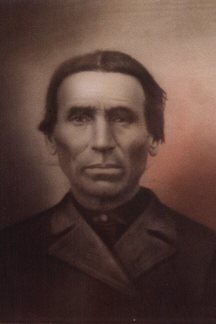
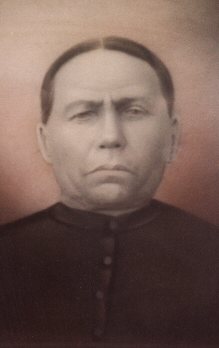
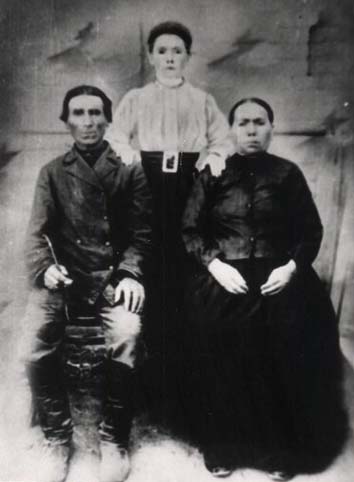
and one of their
daughters
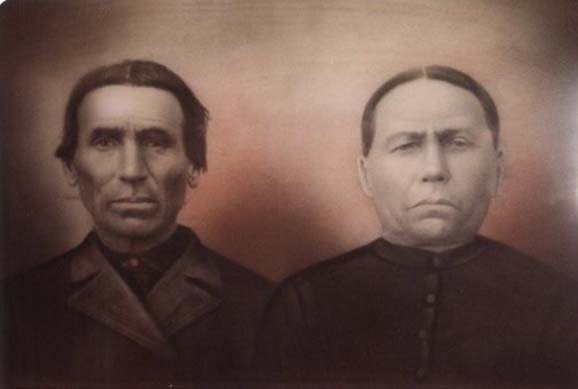
Margaretha Mehler
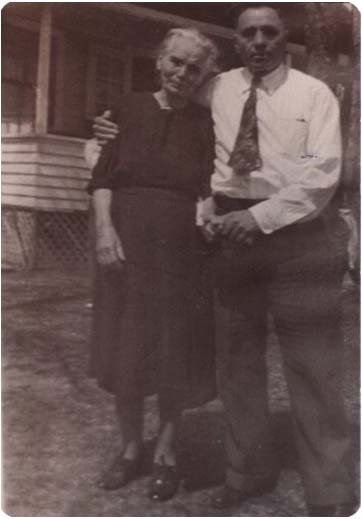
Magdalina
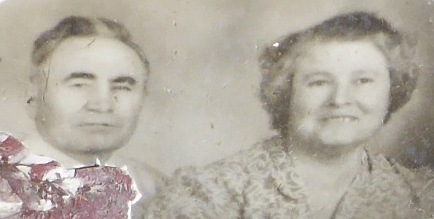
(Mornheiser) Mahler
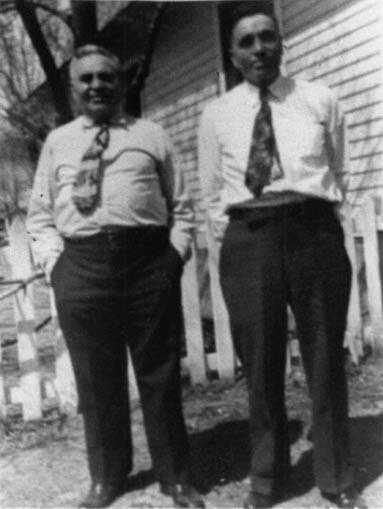
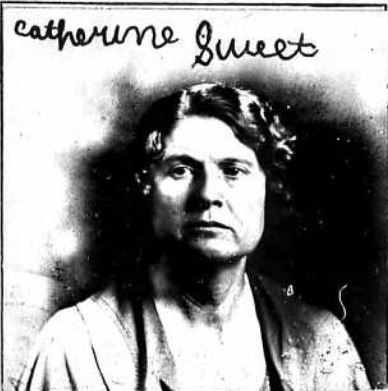
(Mornheiser) Sweet
(later Mahler),
photo from her
naturalization
papers)
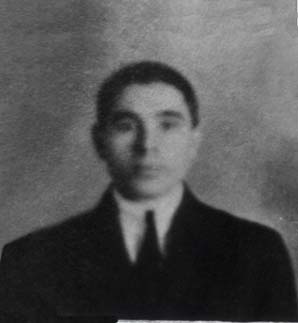
man
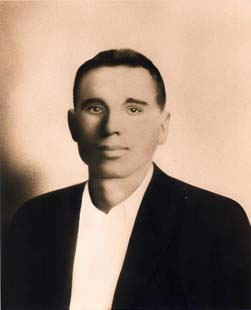
photo
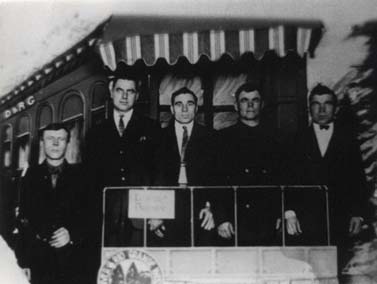
with others on train
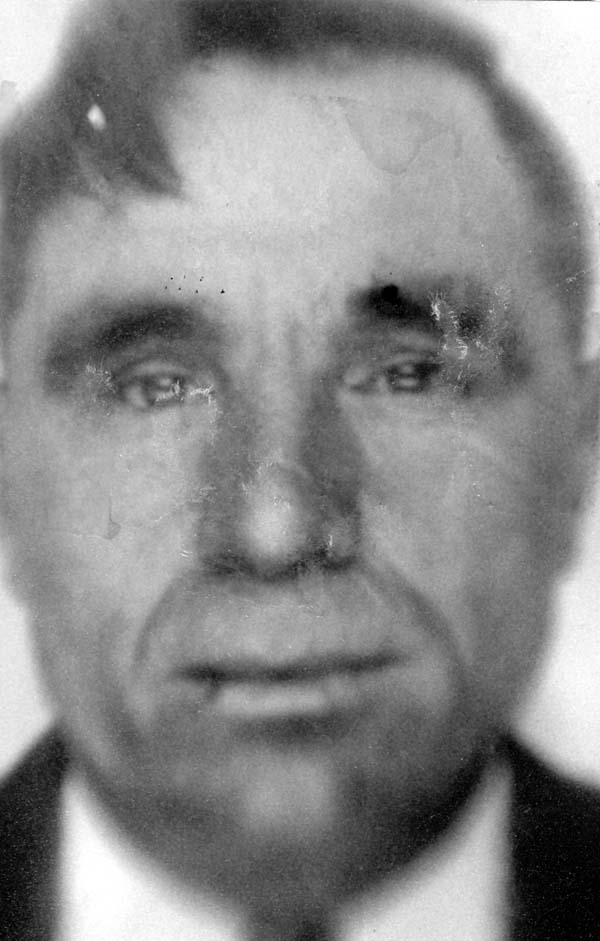
aged man
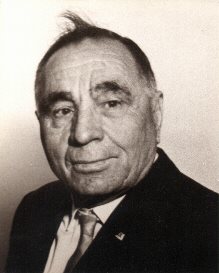
aged to older man
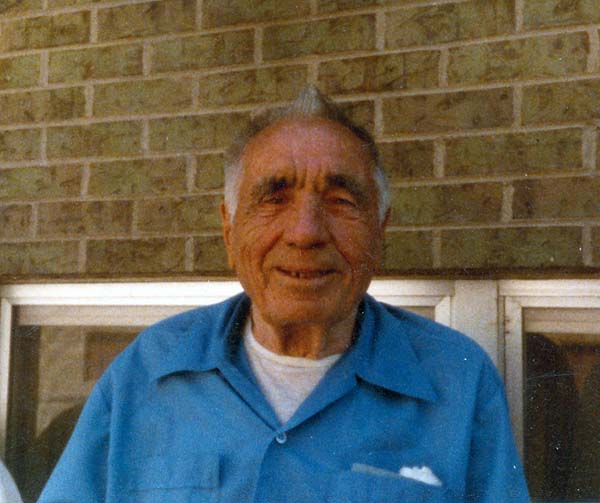
man

man
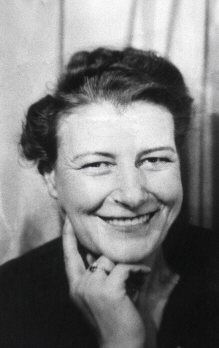
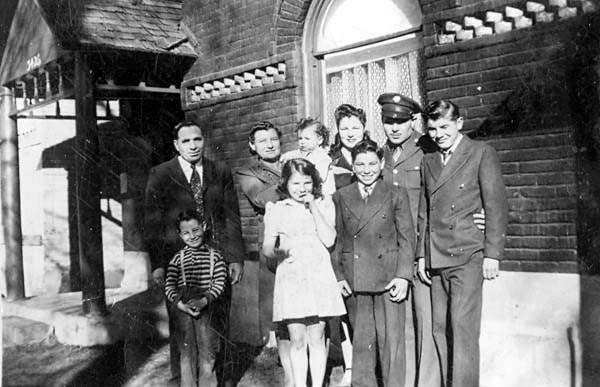
(left to right):
Jacob, Rose,
Janice, Josie,
John, Andy
In front: Mike,
Lorraine, Pete
Source Materials
Click on each category below to expand and see the copies of sources used to create the biography above (copyrighted and other restricted items are listed in the summary of sources above but not included below). Click again to close.
Transcripts of an Interview with Jacob John Mahler by grandson, Frank Jaycob Boyd
HOW MANY WERE IN YOUR FAMILY? HOW MANY BROTHERS AND SISTERS DID
YOU HAVE?
Four brothers and sisters, two of each.
WHAT WERE THEIR NAMES?
John and Jake and Margret and Barbra. Barbara es war die Younge,
the little one.
WHEN YOU LIVED BACK THERE, WAS YOUR DAD A FARMER?
Ya, he had a section of land in the old country. Now how much is
a section of land here? That's four, four, and 160 on each
corner, a 160 acres. Four times six is how much? 24, OK
and four times six again, that's ten acres, see, and then the other,
that's two acres or three acres, see, it's all figured out.
Mama, she figured all that out.They send over here how many acres and
she went in the book and find out what that was. It was a little
more than an acre here. I don't know how much but a little more
than an acre here.
DO YOU REMEMBER YOUR GRANDPA?
Ya, just a little.
WHAT WAS HIS NAME?
Johnnas...John.
WHAT WAS YOUR GRANDMOTHER'S NAME?
Margret, I don't know, I never, she died young. I wasn't even born
when she died.
HOW MANY AUNTS AND UNCLES DID YOU HAVE?
Four uncles.
WHAT WERE THEIR NAMES?
Andrew, Mike, and Pete and...I don't know.
WHAT WAS THE FIRST ONE AGAIN?
Andrew.
SO THERE WERE FOUR BROTHERS?
Uh huh.
AND WHICH ONE WAS YOUR FATHER?
Peter. Did I didn't name that? Didn't I name that?
Didn't I name Peter?
UH HUH. WHAT DID YOUR GRANDFATHER DO? WAS HE A FARMER TOO?
Oh, he had, I don't know how many. He had a lot of land. Oh ya,
he gave my father a section of land, five-hundred and some
acres. That's what we got and we got a pair of oxen and four
head of horses, cows, sheep, hogs, chicken, anything and that's what I
got my father from his dad, that's what he got from his dad.
YOU TOLD ME BEFORE THAT HE BUILT THEM A HOUSE OR HELPED THEM BUILD
HOUSES.
They did...No. You know them houses were built like that,...what
they call them?...a section...or a half-section...or 160 acres?
Whatever they call them.
A HOMESTEAD?
Ya, my grandfather had a homestead from Germany.
HE CAME FROM GERMANY? YOUR GRANDFATHER DID?
My grandfather did! No! My grandfather's father.
They came from Germany! The Germans pushed them over there and
gave them all the land they want.
THAT'S YOUR GRANDFATHER'S FATHER?
Father, ya. Great-grandfather came from Germany.
DO YOU KNOW WHAT HIS NAME WAS?
No, I don't know. We don't have much talk about it. So, I don't
know what the heck to tell you.
NOW, HOW DID YOU HAPPEN TO COME TO THE UNITED STATES?
My father, he was an inspector. He was a man, find out what the
world does. Now here, they had a section of land or more and you
know we bought machinery and out there the neighbors, I, and the
machine. On a machine, we harvest, we scythe it, we plant our
seed, we farm a farm. And I used my machine, whatever it was and
the neighbors used it but they had four or five men and they helped
me.
NOW, WAS THAT AFTER YOU GOT TO THE U.S. OR BACK IN RUSSIA?
Back in Russia. Ya, and then my father wasn't satisfied he gonna
give him the money to send him over here. And, then, when he was
over here one year and he says,"Daddy, I want Jakob over here, Jacob,
Jake, your brother. Came over one year and said he wanted
Jake. Ya, he wanted me over here and that's what I got.
NOW, WHAT DID YOU DO ON THE MACHINE? DIDN'T YOU RIDE ON IT, YOU
TOLD ME?
Ya, I put four head of horses on it and I cut the wheat, barley, pats,
whatever we had. Potatoes, the potatoes are stuck on the top,
you know, they cut them off. They used everything and we had the
machine. Plows, we had a plow and put a tractor on the farm.
A TRACTOR?
A machine.
IT WAS HORSE DRAWN, THOUGH? PULLED BY HORSES?
Ya, some we had was pulled by horses. The double header was with
a machine and one plow. We had one head of horses on one
plow,you know what one plow is? And the other one was two plows
and it had a motor on it. They had a machine on it.
AND THAT'S WHEN YOU WERE A BOY IN RUSSIA?
Uh huh.
SO YOU CAME?
Uh huh. I was over a couple of years and we had money
saved. We worked in one pocket book, not split. We had
enough money to bring them over here. Sister and the
Brother-in-law, Mother and Dad. That's four, five of them.
---------------------------------------
TELL ME THAT AGAIN IN ENGLISH.
Oh, Russia stopped them from coming and Germany. He went home to
Germany. I don't know how they work that. You know, he
paid to get me back or whoever it was and my Mama and Dad and sister
and her husband. They made us go back.Tell them they couldn't do
nothing. We had $4,000. We had to put $2,000 extra to support
and the rest of 'em was for fare and support for coming over here.
WHATEVER HAPPENED TO THEM?
They took 'em back. They starved my dad to death. They
didn't give 'em nothing to eat. And we sent them $27,000 now.
Rubles, we send 'em out to bring them over, see? That would take
that much and a little bit more and they had a good security to come
over and they stopped and took everything from them.
WAS THAT THE BOLSHEVIKS?
Ya, Bolsheviks. '13 or '14. I still remember that.
WHAT HAPPENED TO YOUR MOTHER?
They died! Starved 'em to death. Well, they were
old. Mama was 70 and my Dad was 80 or something, an old man,
too! Like I am now. And mother was 70, maybe 75, or
whatever it is. You know they didn't have no way to know.
I had a passport. I still got it. Tells my time on there.
HOW DID YOU FIND OUT THEY HAD DIED?
They sent over here, they sent a over. See the dead, they send a
document. They let that go through.
JUST A LETTER?
Ya, just a letter.
YOU GOT A LETTER SAYING THEY WERE DEAD?
Uh-huh. And my brother-in-law, they took him in the army. I don't
know. We never found out what happened to him.
AND YOUR SISTER? YOU NEVER FOUND OUT?
No, we didn't know what happened. You couldn't find out.
AND THEY WERE ALL FROM LEIGHTING?
Uh-huh. I and my brother, we tried to find out what they are, and we
had saved money. See, we wanted to bring them over here.
We went through the Red Cross. They couldn't even find their
names.
SO YOU NEVER KNOW WHAT HAPPENED TO THEM?
See, we went through all the big stuff, and, well, whatever, the
importing, whatever you call them where the people come in.
IMMIGRATION?
Immigration. We went through there. Nothing. Through
immigration, Red Cross, Blue Cross, and all kinds of ways and you send
a few dollars and you get it but they couldn't get the persons.
I don't know what happened to them, I tell you, when they went over
there, then, they brought 'em back. That was tough.
YOU BROUGHT THOSE TWO BIBLES WITH YOU?
Uh-huh. They couldn't, the government...I had them tied up so
they could open them up anytime they want to. I had some kind of
twine on that. There's supposed to be the name on that when they
were bought and when they were made.
THIS ONE SAYS 1871.
Okay. This, maybe, they broke off.
YES, ONE PAGE IS GONE THAT TELLS THE DATE ON THIS ONE.
Now, here, when you read...Mama, my wife, could read from there.
GRANDMA COULD READ THIS?
Uh-huh.
WHO GAVE THESE TO YOU?
From my home. Ya, and I had them...if I gave them...I never let my
kids have 'em! Oh no! Well, I would have given them to 'em
but they go and look and look and one of 'em says, "Here, let me look
at it." You know, that's the way they do and one says, "Wait a
minute!" And they get mad and,then, they tear 'em up.
NOW, WHEN YOU CAME OVER YOU WENT TO WORK WITH YOUR BROTHER?
No!
WHAT DID YOU DO WHEN YOU CAME TO THIS COUNTRY?
I work for the Santa Fe railroad company. I went in there.
They say, "Scrub!" Work all kinds of stuff in the shop.
Sweep it, clean it, and put it out in the box in the car and, then,
later on, I got to working and find out what I do and, then, I go out,
out to Kansas. I work one year in that shop steady and, then,
Kansas. Good money! $75. In ten days, you had
$75. Okay. And I went for...and my brother went for...he
was out there, too. And he told me to come on out and I went out
and worked for one family there six months, or three months, or four
months. They wouldn't let me loose! They wouldn't let me
go! We stayed there. "Come on we got work for you! A
dollar a day and board and room."
HOW OLD WERE YOU THEN?
Fifteen.
AND HOW LONG DID YOU WORK IN KANSAS?
Eight years.
DOING THAT SAME JOB?
No, no, no! I had two people out there working the harvest and
one on the machine. I had three men out there I worked for every
year for eight years. Thrashed on the machine, you know, the
machine you got to pitch the wheat in, whatever you got. Barley,
oats, or whatever you got. And I done that for eight years and,
then, I got hooked with Mama.
IN BETWEEN THE TIME YOU WERE WORKING WITH THE FARMING, DID YOU GO BACK
TO THE SANTA FE?
Ya, in the winter time, I go back. Three times the company hired me!
Three times! And I worked. I forgot that! Every time I go in and go
down to the boss, "Come on in, put your clothes on, come on in!" And
my brother got so mad he didn't know what to do. They hired him once
and never took him back no more!
WHAT DID HE DO AFTER HE QUIT?
He got to go around some other place. Some other work, big work, heavy
work.
BUT THEY HIRED YOU BACK THREE TIMES?
The Santa Fe? Ya! They hired me three times. The same darn boss, the
same bird I worked on the machine. You know the machine, a long
machine with a table. I built frames. I cut frames. You know them
frames, they're broken and they weld them, and I put that frame on the
bed. You know that's a great big bed. Well whatever, forty feet long
that engine, or whatever it is, and I tie 'em down, and then I put my
tools on my cutter machine. And when I get there, cut 'em off -them
chips. They couldn't have 'em. You know the firebox go on there, and
its got to be smooth. The frames got to be smooth to get the firebox
on the engine. I didn't have no trouble at all. Three times, then the
fourth time I didn't go back, I came out with Mama.
DID YOU MEET GRANDMA WHILE YOU WERE WORKING AT THE RAILROAD OR
FARMING?
Farming. I worked for her mother. She hung on to me, take care of me,
let nobody happen, nobody say anything. She was my protector. She had
me, and nobody was nothing to do. What she said, and I done that, and
that was it.
AND THEN YOU ASKED HER TO MARRY YOU?
Ya, but one time her oldest brother, he was out here, Mike, her oldest
son. He says, "Mama, if you was a little younger you would have
married Jake! That's what he said.
THAT WAS GRANDMA'S BROTHER?
Ya, Mike, he says, "If you were younger, you would have married Jake."
That's how I got my shot whiskey every day!
WHO GAVE IT TO YOU?
Mama...Mama's mother! Every lunch, you know, when you go out
harvesting, you get a lunch. Ten o'clock, and two o'clock, you get a
lunch, and then's when I got my shot every day!
THEY BRING THE LUNCH TO YOU?
Ya, they were not in the house. They were out in the field and you
couldn't afford to chase them guys' horses home. And they stopped,
rest the horses a little bit, and eat.
HOW LONG DID YOU WORK? WHEN DID YOU START IN THE MORNING?
Oh, about 7:00...7:30. End of the day, 4:30, 5:00.
AND YOU STOPPED TO EAT TWICE?
Uh huh. We eat. At noon we have a heavy eat. Two o'clock, we got a
little sandwich, on a piece of bread with a piece of meat in there,
and the same way at 4:00, they had a doughnut or something. You know
at that time they baked a lot of stuff, and you got something like
that.
AND WHEN YOU QUIT AND WENT HOME FOR THE NIGHT, DID YOU EAT WHEN YOU
GOT HOME AGAIN?
Oh, ya! You get hungry. I didn't have no dry clothes on when I got
back!
YOU SWEAT LIKE MAD, HUH?
Ya, and my wife, she load the box, you know, she load the box and the
elevator, bring it up, and she load it, and I unload it. And her
brothers they were on the stack. You know, build the stack. Oh well,
that's a long time ago, and a lot of work.
TELL ME ABOUT WHEN YOU AND GRANDMA GOT MARRIED. WHERE DID YOU GET
MARRIED?
Where'd I get married? Down in the same place, in the church.
WHERE DID YOU GUYS COME FROM TO DENVER?
Hayes. At Hayes, you know, Hayes. In St. Peter, that was Mama's home.
AND THEY LIVED IN ST. PETER?
Uh huh...No! They don't live in St. Peter, they live on the farm, but
they had a little home in there, a little house, in St. Peter. They
cook, and eat, and whatever they had to do, and repair sometime. You
know they sent for repair and that's where the repair go to in St.
Peter.
YOU WENT TO THE LITTLE CHURCH IN ST. PETER?
Oh, ya!
WHAT DID THE LITTLE CHURCH LOOK LIKE?
That was a wooden frame, and they tore it down, and build a brick one,
a brick church.
ON THE SAME SITE?
On the same place, but they tore it down. You know them old homes,
they got old, and couldn't keep up the repair any more. They didn't
hold together anymore.
COULD YOU BUY WHAT YOU NEEDED IN ST. PETER?
Ya, they had a couple stores. Whatever you want to buy, whatever you
needed to buy there.
WHY DID YOU COME TO DENVER?
Well see, in the fall, the work went down on the thrashing machine.
Well, I had a friend with me, he was a neighbors in the old country.
He had uncles over here, oldtimers, old guys come over here in 1912, a
long time ago. And he went there, and he stayed there. Well, when it
was raining, or bad weather, and we couldn't work on the farm, we went
over there. If you didn't go, where we stayed, they always said, "Go
over there", and we all want to go, and the whole bunch go over there.
They played cards, and they drink beer, whiskey, had a good time. You
know, not a rough time, a good time. We came here to Denver looking
for work, see.
WHO CAME?
I and my friend. My brother was out here already.
WHERE WAS HE AT?
Right here in Denver, and he came out, an we came out. The third day I
was out here I got a job. Ya, three days out here, and I went to a
foundry, Queen City foundry. That's on Third and Mariposa, or
someplace down there, and I went there three times, and they hired me.
WHAT DID YOU DO THERE?
I worked on the machine. You know what I done, I run a screener, and I
screened sand, and put water on it, and put the stuff in there where
they make forms with. That's all I did them days, and they all said,
"Darn it, how come you got a darn good job, and we can't get 'em?" I
got them jobs all the time, good jobs, and well, when I was out there
one time, I didn't have no ...... They sent letters to Denver, "Come
out. We need you." They tell me what they pay me and everything. Board
and room, $75, 10 days, 9 1/2, that's what they usually work.
WHEN DID GRANDMA COME OUT? YOUR WIFE?
Oh, my wife, didn't come out. That's when I worked. I was single then.
I worked there a long time, see. Four or five years, then. See when I
went out there, and the people found out who I was, and what I do, my
people who I work for, he told me who I was, and what I do. Everybody
wanted me to go, and finally I go out there, and...I don't know, her
brother Mike, Uncle Mike, I call him, he was out there looking for a
man, and you know they talk. We were staying there together. Well, you
know we were all staying together, looking for work. OK. I don't know
what I say. He came, Mike, he says, "You have a job?" I said, "Not
right now, but I get one here in no time, in a day, or so I get one."
First thing I know I got...girls. I got three girls, sisters. I says,
"You going to hire me?" He did! Honest, he did! That's when I got
hooked to Mama.
SHE STARTED TO BRING YOU LUNCH OUT TO THE FIELD?
No, she was in the header box with me. In the box. She drove the
horses in the box, and I load the box, and unload it.
SHE WORKED OUT THERE WITH YOU?
Uh huh. She worked right there with me.
BUT YOU STILL WEREN'T MARRIED WHEN YOU CAME TO DENVER?
No.
WHAT DID YOU DO, SEND FOR HER?
No, I went out there every year...eight years. Back and forth, all the
time. All eight months, I think...in 1920, fourteenth of...you know.
AND THEN YOU GOT MARRIED HERE IN DENVER, AT THE CHURCH?
Uh huh. Oh ya, St. Elizabeth's Church, down here. Oh that priest, he
died, but he talked to me, and, that man of Christ, he just fall for
me, that priest in the church. And I said, "Father, I don't know,
could you marry me?" "Oh, yes", he said, "Sure! Yes! Who ya got?" I
says, " I don't know who I got, but I show ya! I show ya who I got!"
And then I went out and harvest, and done the harvest, done the
machine, and then, I and Mama went on the train. We came to Denver.
THEN YOU GOT MARRIED RIGHT AFTER YOU GOT HERE?
Ya. I came in the day, and a couple days later, I got married.
HOW COME YOU GOT MARRIED HERE, AND NOT BACK THERE?
I don't want to tell you! No, her mother wanted me, and her brothers
didn't want me.
OH, THEY DIDN'T LIKE YOU?
No. They didn't like me, and my brother didn't like them. They were
against each other all the time. And I said, " Brother, you know when
you get married, you got a lot of life! A good life! When I'm like
you, you're single. You run around. I don't want that!"
YOUR BROTHER NEVER MARRIED?
Ya, he got married when he was sixty years old.
HE DIDN'T WANT YOU TO GET MARRIED?
No, and I didn't listen to nobody. When I met Mama, and then...goodbye
wealth. You know what I say. Goodbye world, and nobody stop me. I
don't know we were stupid, all the time, and we were so holy. You
know, we didn't know any better, and we had eight kids, nine kids,
right away. We didn't have no sense! I know what I done. Now here you
don't have to have 'em.
YOU DIDN'T LIVE IN DENVER ALL THE TIME YOU HAD KIDS? YOU MOVED AROUND
TO DIFFERENT PLACES?
No. I didn't have to go very far. I had a job. I stayed here in
Denver. I worked thirty years for public service. I start in 1937.
WHERE DID YOU LIVE WHEN JAKE AND JOHN WERE BORN? IN DENVER?
No. They were out...John was born on 8th Street, down by St.
Elizabeth's. That's where two of them were born, down there. I had a
job. I worked for the foundry, Queens City Foundry. And I stayed there
a long time, three or four years.
WHERE DID YOU LIVE WHEN FLORENCE AND JOSIE WERE BORN?
Down on Brighton Blvd. I owned a home. I was silly, I bought a home
from the state, the county, and I give it to Mama. Her name was on it,
not mine, and you know, later on we wanted to go on the farm. And I
had $1,500, and I need more, and I asked my brother for $1,000, and he
give us that, and I give him that darn mortgage, that house. And it
was bad years then, '17 or '18, whenever it was, or '32 or something
like that, and he took the house away from me.
BECAUSE YOU COULDN'T PAY HIM BACK? THE FARM DIDN'T DO VERY WELL?
No!
WHERE WAS THE FARM?
Down at Ovid, Jewelsburg, and all them little places.
WAS THERE JUST ONE FARM?
One farm, twenty acres of beets, frozen. Look at the money. There's
where I lost...hog.
THE BEETS FROZE ON YOU?
Uh huh.
THAT WAS IN OVERTON?
Uh huh.
WHAT WERE YOU DOING IN JEWELSBURG?
That's not in Julesburg, was out on the farm all the time. That's just
the territory, or something like that. That's what broke my neck! I
had enough beets out to pay the company first. You know, that darn
Great Western. You know what I'm talking about. It's the seed. You
know you got quite a bit of seed, and you had enough beets sold,
topped, to pay the bills, the little bills. No matter what we had of
the seed and the money. If we had another check coming, and that would
be ours. That shut us off.
HOW LONG DID YOU HAVE THE FARM?
One year and I quit. I had to quit. I couldn't. He took everything
away, my brother. And then he took it and farmed himself, and he went
broke on the deal.
WHERE DID YOU GO AFTER YOU LEFT THE FARM?
To Denver.
DID YOU START WORKING FOR THE PUBLIC SERVICE THEN?
No. Not right now. I worked for a foundry. I go to the foundry. When I
got experience in the foundry, then you go back there.
THE SAME ONE?
The same one, Queens City Foundry. Ya, heck ya, it's all in life.
AND THEN YOU QUIT THE FOUNDRY AFTER A WHILE?
I went for the smelter. See, I got more money over there, and I quit
the foundry, and they say, "When you're ready, come back!" I went to
the smelter.
WHAT KIND OF SMELTER WAS IT?
Smelter! Where they heat iron. We make rails, and stuff like that.
AN IRON SMELTER, THEN?
Ya, that was a big thing, and I got so far they give me a foreman on
that job. You know when the piece of iron go through a roller, they
rolled it. They're not pressed or pushed. They go in there, and the
machine pulls it through, and I pulled through a couple of them, and I
hot a good job out of it, and I made good money.
AND YOU WORKED THERE FOR A WHILE?
And then I went around and looked. I got a friend, worked for the
public service. And then he said, "If you're in there once, you'll
never quit, you never laid off, or nothing."
WHAT DID YOU DO WHEN YOU STARTED FOR THE PUBLIC SERVICE? WHAT DID THEY
HIRE YOU TO DO?
Sweep the floor, until they know! Then I got on a machine. It didn't
take me long on the machine. Every time I go in a shop, I work on a
machine. When I was fourteen years, or fifteen years old. The first
job I had was on a machine.
WAS THAT FOR THE SANTA FE?
Santa Fe, ya. And I was on a machine all the time.
DID THEY TEACH YOU HOW TO RUN THE MACHINE?
No! They put you over with four men, or five men, that's according to
what kind of heavy job you got. Then you learn. They keep you on
there, and then they find out. The first man on the roll, that's the
big job, and then the second one, and the third one, and the fourth
one, and the fifth one. I was the fifth one. In three months, I was
the first one. That's what made me higher! I worked on the machines
all the time.
WHEN YOU CAME TO THE PUBLIC SERVICE, THEY HAD YOU SWEEPING. DID THEY
HAVE YOU DIG DITCHES?
No! Sweep the floors. What they got them engines, and they tear 'em
down, and put new jackets on. Sometimes new pipes in their flue, and I
done that for three months, and I got a new job, and I stayed there a
long time.
WHEN DID YOU DIG DITCHES?
Ditches? When I worked for the U.P. You know, I worked there, and I go
out eight hours, you know, and I wasn't satisfied, and I go out, and
find me a job, and I dig ditches, and put popes in people's houses for
gas.
WAS THAT IN DENVER?
No, here in Denver.
THAT WAS BEFORE YOU WORKED FOR THE PUBLIC SERVICE?
No! That's when I worked for the public service. That was extra work.
Ya, I never was satisfied.
YOU WANTED TO WORK SOME MORE?
And I did. Worked for long time. And when I started work for the
public service, I bought a home. See, with all this foolin' around,
work here and there, I priced it, you know, I saved it, and I had
$1,000, and I paid for my home.
THIS ONE? YOU BOUGHT THIS HOME ON HUMBOLDT STREET WITH THAT $1,000?
Downtown, not this one. Down on Brighton Blvd., down there.
AND THEN YOU BOUGHT THAT ONE?
And then I looked around, and I wanted more, another home. I didn't
like that home I had, five rooms, and no porch or anything. I walked
down, you know.
AND YOU BOUGHT THIS HOUSE IN 1937?
Uh huh.
HOW MUCH DID YOU PAY FOR THIS HOUSE?
$1,000, not too much. $1,000, and I paid it off in four years. I
didn't have to pay no...that was city and county. I bought that from
the city and county. The people died, and they didn't leave nothing
here, and everything went to the county.
IT WAS REPOSSESSED, THEN?
Ya, and I found that out. I had people read that to me, see. I say,
"I'm gonna get that! Oh ya, get that!"
HOW OLD WAS THIS HOUSE? WAS IT AN OLD HOUSE WHEN YOU BOUGHT IT?
Ya. This house is a hundred years old. OK. In 1937, and I bought the
place. In four years I paid it off. My wife had a house. I give her
all. I was foolish to do that. See, when she got old, and died, you
know, I had it paid. I had to buy this house, not the house, but a
paper. Cost me a hundred and some dollars to get it in my name. See,
I'd saved that hundred, and but I didn't have it on there. She had it.
Mama go do what she wants. That was my trouble. do what she wants, and
she did.
WHAT HAPPENED TO YOUR BROTHER THAT LIVED HERE?
He died.
WHEN?
I don't know. A long time ago. He got that house down there where I
was in. He chased me out. Well, the law. He didn't do it. But I'm
sorry, he drove us out. Nothing we could do. We signed it.
HE CAME FROM RUSSIA THE YEAR BEFORE YOU?
Uh huh.
FROM LEIGHTING?
Leighting...Leighting. We had three or four different guys here. My
cousin, he went to South America. See, my Dad's brothers son got his
share, what my Dad got. Them old people they stick together. His son
got what I got, by my Dad got. He stepped in his Dad's place, and got
what my Dad got, and then, he sold that, all that stuff, and went to
South America. See, he had friends, you know, with his wife, he talked
about it, and he done it, and he went over there, three years, and he
came home with all kinds of money.
ALL YOUR AUNTS AND UNCLES LIVED RIGHT THERE IN RUSSIA WITH YOU?
Ya, all in one block. See, them people, when they bought, they bought
not one, they bought the whole block........three sons. One son stays
with their father, and them other two, three, they have to find a home
for them, and that's what they done. They bought a half a block or
more, whatever it took. The sons bought it. That's what they done.
NOW, WHEN YOU WERE LITTLE, YOU WERE ON THE FARM. DID YOU HAVE A HOUSE
IN THE TOWN, TOO?
We had a house in the town. A nice house, big one.
WHAT WAS IT MADE OF?
Lumber, and inside, plaster. Mud and stone. I don't know if you ever
heard of that or not, but that's what they had. You know, they used
them squares.
BLOCKS?
4 x 6, or 4 x 8, or 4 x 12. You know, big logs, they had, and then
they put 'em together like that.
CRISSCROSSED?
Uh huh. And they filled them up, and then they go inside, and take a
hammer, and there was a point, and they hit the maul, and they made a
hole in there, and put a peg in there.
AND IT WAS PEGGED TOGETHER THAT WAY?
Ya, and then they put the mud on there on the inside, and the straw.
And then they...we had white paint. Go out there, and dig it, and
clean it off. You can make paint out of it, and they paint that inside
with the white paint, and they put the plaster on, a fine stuff, all
kinds of stuff in there, and when they peg it, it stays there forever.
THEY PUT PLASTER OVER THE MUD?
Uh huh, little plaster, mud.
AND IT WAS A BIG HOUSE?
Ya.
HOW MANY BEDROOMS DID YOU HAVE?
We had four bedrooms, and our house was big. I don't know, forty or
fifty feet long.
DID YOU GO BACK TO THAT WHEN YOU WERE FINISHED FARMING EACH DAY?
In the winter time, ya. In the summer time, too, when you didn't have
nothing to do anymore on the farm. See, you farm, and then you got a
stall in May, first of May, a holy month. Russia had churches...day in
and day out in May, and that's what my people had, too. They didn't go
to work or nothing unless you had to have work, then you have to go to
work, but if you don't, then you didn't have to.
YOU DIDN'T WORK IN MAY UNLESS YOU HAD TO?
No. That was a holy day. You got to go to church. You got to church.
Your Mother and Father, they wouldn't do that, leave you at home. No!
You didn't have to dress up. You go to work out in the farm, take that
clothes off, and you had extra old clothes, heavy clothes, put it on,
and go to church.
HOW MAY PEOPLE LIVED AROUND YOU THERE, A LOT OF PEOPLE OR JUST A
LITTLE BIT?
No! A lotta people. Oh my, ya. We had three....lines. Three rows on
each side was full of houses. And people in there. We had two houses
on each street.
AND HOW MANY STREETS?
Three.
SO THERE WERE SIX HOUSES?
Six houses. Six houses, and they were a mile or more long. Well, their
houses were fifty feet long.
HOW CLOSE WAS YOUR NEAREST NEIGHBOR?
Neighbor. No place.
HOW LONG WERE THE BLOCKS?
Uh, no, they were just as long, or a little longer than these here.
AND THERE WERE SIX HOUSES, TWO ON EACH BLOCK?
Ya.
AND THAT WAS THE WHOLE TOWN?
They only had two families. My father had three sons, and they were on
that block. And the neighbor had two sons. They were on that block.
AND THAT WAS IT?
That's it. And the side had the same thing. And wherever they had a
family, they go out, they have a block.
HOW MANY FAMILIES WERE THERE IN THE TOWN? JUST A FEW?
Not very many. No, well quite a few anyhow.
AND THE LITTLE TOWN, DID THEY HAVE STORES AND THINGS?
Ya, we had a store where you buy...buy something to eat, and then they
had something where you buy yard goods, see. And when you make a lot,
and good stuff, you know, you go to town. Big town. Was fifty miles
from us, and they go in there, and they buy our, sell our grain in
there. They put four sacks of grain on the wagon behind two head of
horses, and take it to town, that's fifty miles. Take 'em two days.
They go one afternoon, and go until the next day at noon. We used the
cool weather. We don't want to go in the afternoon. It's too hot.
SO THEY STOPPED FOR THE NIGHT, AND GO THE NEXT DAY?
Go the next day. And you buy everything you want. You buy the leather
for shoes. You buy the clothes.
DID YOU MAKE YOUR OWN SHOES?
No, they had a regular man in town, he made them. Had two men. Two
full paid men, apprentice, two apprentices. They learn how to make a
shoe.
HOW OFTEN DID YOU GO TO TOWN?
We were in town! After we get off, we go to town. We had our house,
barn, horses, cows, chickens, hogs, all in town. We had a long, well
that was fifty feet, our lot. They had barns in there. Sections where
we had hogs, little places. We had the hogs in someplace. We had the
sheep someplace. The cows someplace, and the horses someplace.
WHERE YOU GREW THE GRAIN WAS OUT OF TOWN? WHERE YOU SOLD IT?
We had a grainery. You know what a grainery is.
YOU HAD TO TAKE THE WHEAT SOMEWHERE ELSE TO SELL IT, THEN?
Uh, ya.
WHAT WAS THE NAME OF THE PLACE YOU TOOK IT TO?
Uh, Saratov......was on fifty miles. Saratov was a hundred and fifty
miles.
DID YOU GO THERE VERY MUCH?
Ya, when they had a nice wheat. They clean it, fix it up, and put it
in a sack. They drive it in there. They get more money.
DID YOU GO TO SARATOV?
Saratov and ___________. That was the name. I went with my brother.
The brother was in the front wagon, and I had my wagon behind him. I
had to follow him. My father was over there in the front with the big
horse. I call him the big brother, you know, and I followed him. You
know them horses, they were trained. They never go out of the line.
They just follow the wagon, and all you have to do, you want to stop,
is hold your line a little.
HOW OFTEN DID YOU HAVE GRAIN TO TAKE OVER THERE TO SELL?
In the winter time, two or three times, according to how much grain
you have to sell.
TWO OR THREE TIMES IN THE WINTER?
Uh huh. That's where you got your money, and your living. Then you
save so much grain for seed, in the spring. That's a long time ago. I
remember, when my brother went over. My father says, "Jacob, what your
brother did, that's what you're going to do!" And don't no mistake,
ask me. Don't do it without asking, if you don't know. If you know,
keep on going."
HOW COME YOUR BROTHER DECIDED TO LEAVE THE FARM AND COME TO THE U.S.?
That's not my brother, that was my father! He done that. He wanted to
know what's going on! Ya, he says, "Go over there!" He gave him the
money to go. Cost him $200, I think. At that time that was a lot of
money, and the he was over here, and he liked it."
WHAT WAS IT LIKE COMING OVER IN THE BOAT?
Oh ya, good!
WHAT DID THE BOAT LOOK LIKE?
It's a great big boat! I had it on the paper.
A STEAMSHIP?
A steamship, a great big one. There were three certain men on there,
the married men, the single men, and the family men. They were all on
the ship together, and each people had their own place on the ship
where they go. They don't go all together. Single men and married, all
were separated. If you were married, you go in the married business.
WERE THERE ALL GERMANS ON THE SHIP?
Almost all, ya! Almost all the time, them people they worked together
more than they do now. My father he hired somebody. They took me to
the railroad, 35 miles. 35 miles I had to go to the railroad. I
go to the train, go through Russia, and through Germany, and to the
water.
WHERE DID YOU GET THE BOAT AT?
In Baltimore!
HOW LONG DID IT TAKE YOU TO COME ACROSS THE OCEAN?
Seventeen days.
THEY GAVE YOU FOOD TO EAT AND EVERYTHING?
Food to eat and everything.
DID YOU GET SICK?
I didn't get sick, but I wasn't far from it, either. My father gave me
a little whiskey with me...vodka. I didn't take too much, just a shot
if you feel really bad.
DID YOU MAKE THAT?
I brought it from home. They bought it cheap - two or three cents for
a gallon.
SO YOU TOOK THAT, AND IT KEPT YOU FROM GETTING SICK?
Uh huh.
WHAT DID YOU DO ON THE BOAT?
Nothing, walk around. They had the sailors with you all the time, and
you go on the rail, and look there, and they watched you. If you done
too much, they come and tell you to stay away. They go there and look
down.
WAS THE WEATHER PRETTY GOOD COMING ACROSS?
We had one or two days of bad weather. Wind, rain, ice in the summer
time! That was a nice trip, and they eat. Every day you got your
plates, and they give it to you, and you have to keep it, and when
every day come. The eats came in the morning and at noon. You take
your plate, and go alone, and they fill it. Whatever you want. You say
it's enough, and they quit. You say put more in, and they put more in.
AND THAT WAS THREE TIMES A DAY YOU GOT FED?
Two times a day. In the morning, and in the afternoon. People didn't,
they laid a long time. You eat heavy, and they give you sometime baked
stuff, doughnuts, whatever they make.
WERE YOU GLAD TO SEE LAND AGAIN?
Ya, we came to Philadelphia first. That's where we landed first, but
we couldn't get off. We had to go to Baltimore. They let the men off
to buy tickets where we go.
YOU DIDN'T SPEAK ANY ENGLISH, DID YOU?
No, just German.
THE GUYS ON THE BOAT SPOKE GERMAN?
Ya.
DID YOU STOP AT ELLIS ISLAND IN NEW YORK?
No. Philadelphia, and then to Baltimore. See those bunch of people go
there. They had a load of heavy weight on the bottom. Pipes, four feet
or six feet, and they took them off. They had to put the weight on to
keep the people balanced.
WAS YOUR BROTHER THERE WAITING FOR YOU AT BALTIMORE?
No.
WHAT DID YOU DO WHEN YOU GOT OFF THE SHIP?
I went to Baltimore, and then I went out to Denver.
AND YOUR BROTHER WAS THERE?
__________________and then we went to harvest, and then we went back
to Denver. That's a lot of things, how you get over here, and how you
have to do things. Feed yourself. You have to wash your clothes. They
give you hot water, but you got to wash it yourself, your soap.
HOW MUCH STUFF DID YOU BRING OVER WITH YOU?
I had quite a bit of stuff. I got a trunk. Out there is the lid for my
trunk. The trunk is downstairs. I had it down there in the basement.
All at once I thought, I'm gonna do that. I'm gonna get up, and go
open it up, and clean it out, and fix it up, and I did. And I got the
lid, the top, the lid. It's up here on the porch.
CAN I SEE THE TRUNK?
Ya!
LET'S GO SEE THE TRUNK!
Köhler Church Records
Mehler-Nahm 6.11.1873
Column 1: Peter Mehler
Column 2: 37 (Index of record in current month)
Column 3: 6th of November
Column 4: 6.11.1873 in Karaulny-Buerak Romic Catholic Church priest
Philipp Dorzweiler announced
three times, which were made on 28th of october, 1st of november and
3rd of november.
Column 5: Colonist Peter Mehler, yooung man (in this case means
unmarried before) 19 years old with
maiden Margaretha Nahm, 20 years old, both from Ilavlya (Leichtling)
of Karaulny Buerak (Köhler)
parish in Ilavlya (Leichtling) married.
Column 6: Colonists Johann Mehler and Elisabetha Schäfer, legal
spouses's son and Matthias Nahm and
Katharina Schtremel, legal spouses's daughter with witnesses Gottfried
Schäfer and Peter Sänger.
Mueller Margaretha 27.09.1858
Column 1: Müller
Column 2: 182 (Index of record in current month)
Column 3: 27 (day of birth)
Column 4: 28 (day of baptism)
Column 5: 28.09.1858 in Karaulny-Buerak Romic Catholic Church the baby
named Margaretha is baptized
by abbot of Karaulny Buerak Romic Church Johann Lozinsky with the
performance of all rites of the
sacrament.
Column 6: Colonists Johann Müller and Elisabetha maiden name Berger,
legal spouses's daughter was
born 27.09.1858 at night (basically 28.09) in Ilavlya (Leichtling).
Column 7: Receivers were colonists Feid German with Margaretha
Bierwert.
Column 8: Godparents were colonists Nicholaus Berger and Gottlieb
Muffert.
Mehler Peter 15.10.1855
Column 1: Mehler
Column 2: 162 (Index of record in current month)
Column 3: 15 (day of birth)
Column 4: 15 (day of baptism)
Column 5: 15.10.1855 in Karaulny-Buerak Romic Catholic Church the baby
named Peter is baptized
by abbot of Karaulny Buerak Romic Church Johann Lozinsky with the
performance of all rites of the
sacrament.
Column 6: Colonists Johann Mehler and Elisabetha maiden name
Klitsch(??? very probably misspelled),
legal spouses's son was born 15.10.1855 in Ilavlya (Leichtling).
Column 7: Receivers were colonists Peter Dieser with Barbara
Gergenster.
Column 8: Godparents were colonists Valentin Messler and Jacob Mehler.
Mehler-Miller 29.1.1880
Column 1: Mehler
Column 2: 5 (index of marriages in this month)
Column 3: 29 (day of month)
Column 4: 29.01.1880 in Romic Church of Karaulny-Buerak (Köhler)
Parish the marriage has been confirmed. (Simplified translation,
because there some kind of religious formula used)
Column 5: Colonist Peter Meler, widower, 24 years old with Margaretha
Miller, maiden, 21 years old, both from colony Ilavlya (Leichtling) of
Karaulny-Buerak (Köhler) Parish.
Column 6: Village colonists Johannes Mehler and Elisabetha Schefer
(Schäfer?), legal spouses's son and Johannes Miller and Elisabeth
Berger, legal spouses's daughter. Witnesses are Peter and Matthias
Schneider.
Source: Köhler church records in the Saratov Province State Archive,
research by Dr. Igor Pleve, November 2019, translation by Wadim
Eichmann.
Line number Year
Birth
Baptism Given name
Father
Mother
Colony
Parish of record
162 1855 Oct 15 Oct 15 Peter Johannes Mehler Elisabeth Schäfer Leichtlin
182 1858 Sep 27 Sep 28 Margarethe Johannes Müller Elisabeth Berger Leichtling
209
1874 Aug
23 Aug 24 Anna
-- Meller
Margaretha Nahm
Leichtling Köhler
64 1881 May 31 May 31 Sophia Peter Meller Margaretha Mueller Leichtling Köhler
32 1884 Feb 2 Feb 2 Magdalena Peter Meller Margaretha Mueller Leichtling Köhler
376
1889 Dec
24 Dec 24
Margaretha Peter Meller
MargarethaMueller
Leichtling Köhler
Source: Boyd, Darryl et al. (trans.), Köhler Parish Records, 1803-1895, Concord, CA, 2021.
Images of the church records are shown below as thumbnails. Click on each of the thumbnails to view a larger version of the records in another tab.
St. Elizabeth's Church, Denver, Denver, Colorado
Source: Photocopy of church record from the files of Darryl W. Boyd.
1857
Leichtling, Russia
| No. in 1850 | No. in 1857 | Names | Age in 1850 | Moved or died | Age in 1857 |
| 18 |
20 |
Georg Mehler | 43 |
Died 1852 | - |
|
Georg's wife Elisabetha
|
- |
47 |
|||
|
Georg's sons:
|
|||||
|
1. Nikolaus Mehler
|
15 |
22 |
|||
|
Nikolaus' wife Elisabetha
|
- |
21 |
|||
|
Nikolaus' daughter:
|
|||||
|
1) Katharina Mehler
|
- |
½ |
|||
|
2. Jakob Mehler
|
11 |
18 |
|||
|
3. Peter Mehler
|
9 |
16 |
|||
|
4. Michael Mehler
|
1 |
8 |
|||
| Georg's brother Franz Mehler | 38 |
45 |
|||
|
Franz's wife Anna Maria
|
- |
45 |
|||
|
Franz's sons:
|
|||||
|
1. Johannes Mehler
|
18 |
25 |
|||
|
Johannes' wife Elisabetha
|
- |
27 |
|||
|
Johannes' sons:
|
|||||
|
1) Jakob Mehler
|
- |
5 |
|||
|
2) Peter Mehler
|
- |
2 |
|||
|
2. Peter Mehler
|
2 |
9 |
|||
|
3. Georg Mehler
|
- |
7 |
|||
|
4. Johannes Mehler
|
- |
4 |
|||
|
Franz's daughter:
|
|||||
|
1. Elisabetha Mehler
|
- |
13 |
|||
| Georg's brother Peter Mehler | 29 |
36 |
|||
|
Peter's wife Christina
|
- |
34 |
|||
|
Peter's sons:
|
|||||
|
1. Peter Mehler
|
7 |
14 |
|||
|
2. Matthias Mehler
|
- |
4 |
|||
|
3. Andreas Mehler
|
- |
1¼ | |||
|
4. Jakob Mehler
|
- |
1¼ | |||
| Georg's brother Jakob Mehler | 25 |
32 |
|||
| Jakob's wife Anna Maria | - |
26 |
|||
| Jakob's daughters: | |||||
| 1. Anna Maria Mehler | - |
3 |
|||
| 2. Elisabetha Mehler | - |
1 |
Source: Eichmann, Wadim (translator), Leichtling, Russia 1857 Census, Concord, CA, 2019.
Exonerated Persons
5174. Кригер Барбара Пейдеровна, 1896 г., дети: Екатерина Адамовна,
1926 г., Эмилия, 1933 г., Мария, 1937 г., Эрна, 1939 г. В 1941 г.
высланы по национальному признаку, как лица немецкой национальности из
с.Пайхтлин, Добринского района, Саратовской области в с.Колесниково,
Н-Заимского района, Тюменской области.
Реабилитированы УВД Тюменской области 23.04.1998 г.
Source: Реабилитированные лица (Exonerated Persons), УПРАВЛЕНИЕ МВД
РОССИИ ПО ТЮМЕНСКОЙ ОБЛАСТИ (MANAGEMENT OF THE MINISTRY OF INTERNAL
AFFAIRS OF RUSSIA IN THE TYUMEN REGION),
https://72.xn--b1aew.xn--p1ai/gumvd/structure/app_guvd/Informacionnij_centr/Reabilitirovannie_lica/K,
retrieved 30 July 2017.
| Rough translation: 5174. Krieger Barbara Peyderovna, 1896, children: Ekaterina Adamovna, 1926, Emilia, 1933, Maria, 1937, Erna, 1939. In 1941 they were deported on ethnic grounds as persons of German nationality from S. Paihtlin, Dobrinsky district, Saratov region in [to?] the village of Kolesnikovo, N-Zaimsky district, Tyumen region. Exonerated by the Department of Internal Affairs of the Tyumen region on April 23, 1998. Notes:
|
Victims of Political Terror in the USSR
Кригер Екатерина Адамовна
Родилась в 1926 г., с.Пайхтлин Добринский р-н Саратовская обл.; немка;
Проживала: с.Пайхтлин Добринский р-н Саратовская обл..
Приговорена: в сентябре 1941 г.
Приговор: спецпоселение - Н-Заимский р-н Тюменской обл, осв.
31.01.1956 Реабилитирована 23 сентября 1998 г. ИЦ ГУВД Тюменской обл.
Источник: ИЦ ГУВД Тюменской обл.
| Rough Translation: Krieger Ekaterina Adamovna Born in 1926, the village of Paihtlin, Dobrinsky district, Saratov region; German; Lived: [in?] Payhtlin Dobrinsky district, Saratov region. Sentenced: in September 1941. The verdict: the special settlement - N-Zaimsk district of the Tyumen region, [released?]* 01/31/1956 Rehabilitated on September 23, 1998. Information center of the Main Department of Internal Affairs of the Tyumen region. Source: Information Center of the Main Department of Internal Affairs of the Tyumen Region. *осв is possibly short for освобожденный, or "freed, liberated, released." http://lists.memo.ru/d18/f248.htm |
Кригер Барбара Пейдеровна
Родилась в 1896 г., с.Пайхтлин Добринский р-н Саратовская обл.; немка;
Проживала: с.Пайхтлин Добринский р-н Саратовская обл..
Приговорена: в сентябре 1941 г.
Приговор: спецпоселение - Н-Заимский р-н Тюменской обл, осв.
31.01.1956 Реабилитирована 23 сентября 1998 г. ИЦ ГУВД Тюменской обл.
Источник: ИЦ ГУВД Тюменской обл.
| Rough Translation: Krieger Barbara Peyderovna Born in 1896, the village of Paihtlin, Dobrinsky district, Saratov region; German; Lived: [in?] Payhtlin Dobrinsky district, Saratov region. Sentenced: in September 1941. The verdict: the special settlement - N-Zaimsk district of the Tyumen region, [released?]* 01/31/1956 Rehabilitated on September 23, 1998. Information center of the Main Department of Internal Affairs of the Tyumen region. Source: Information Center of the Main Department of Internal Affairs of the Tyumen Region. *осв is possibly short for освобожденный, or "freed, liberated, released." http://lists.memo.ru/d18/f247.htm |
Source: Memorial Society (International Memorial), Victims of
Political Terror in the USSR, http://lists.memo.ru/,
retrieved 14 Aug 2017.
Open List (database of victims of political repression in the USSR (1917-1991))
Кригер Эрна Адамовна (1939)
Дата рождения: 1939 г.
Место рождения: с.Пайхтлин Добринский р-н Саратовская обл.
Пол: женщина
Национальность: немка
Место проживания: с.Пайхтлин Добринский р-н Саратовская обл.
Осуждение: сентябрь 1941 г.
Приговор: спецпоселение - Н-Заимский р-н Тюменской обл, осв.
31.01.1956; спецпоселение - Н-Заимский р-н Тюменской обл, осв.
31.01.1956
Место отбывания: Н-Заимский р-н Тюменской обл, осв. 31.01.1956
Дата реабилитации: 23 сентября 1998 г.
Реабилитирующий орган: ИЦ ГУВД Тюменской обл.
Реабилитация: 20 марта 2003 г.
Реабилитирующий орган: ИЦ ГУВД Тюменской обл.
Источники данных: БД "Жертвы политического террора в СССР"; ИЦ ГУВД
Тюменской обл.
| Rough Translation: Krieger Erna Adamovna (1939) Date of birth: 1939 Place of birth: s.Payhtlin Dobrinsky district, Saratov region. Sex: woman Nationality: German Place of residence: s.Payhtlin Dobrinsky district, Saratov region. Condemnation: September 1941 The verdict: the special settlement - N-Zaimsk district of the Tyumen region, [released?]* 01/31/1956; Special settlement - N-Zaimsky district of the Tyumen region, [released?]* 01/31/1956 Place of departure: N-Zaimsky district, Tyumen region, [released?]* 01/31/1956 Rehabilitation Date: September 23, 1998. Rehabilitation body: IC GUVD of the Tyumen region. Rehabilitation: March 20, 2003. Rehabilitation body: IC GUVD of the Tyumen region. Sources of data: DB "Victims of political terror in the USSR"; IC GUVD of the Tyumen region. *осв is possibly short for освобожденный, or "freed, liberated, released." https://ru.openlist.wiki/%D0%9A%D1%80%D0%B8%D0%B3%D0%B5%D1%80_%D0%AD%D1%80%D0%BD%D0%B0_%D0%90%D0%B4%D0%B0%D0%BC%D0%BE%D0%B2%D0%BD%D0%B0_(1939) |
Кригер Мария Адамовна (1937)
Дата рождения: 1937 г.
Место рождения: с.Пайхтлин Добринский р-н Саратовская обл.
Пол: женщина
Национальность: немка
Место проживания: с.Пайхтлин Добринский р-н Саратовская обл.
Осуждение: сентябрь 1941 г.
Приговор: спецпоселение - Н-Заимский р-н Тюменской обл, осв.
31.01.1956; спецпоселение - Н-Заимский р-н Тюменской обл, осв.
31.01.1956; спецпоселение - Н-Заимский р-н Тюменской обл, осв.
31.01.1956
Место отбывания: Н-Заимский р-н Тюменской обл, осв. 31.01.1956
Дата реабилитации: 11 октября 2001 г.
Реабилитирующий орган: ИЦ ГУВД Тюменской обл.
Источники данных: БД "Жертвы политического террора в СССР"; ИЦ ГУВД
Тюменской обл.
| Rough Translation: Krieger Maria Adamovna (1937) Date of birth: 1937 Place of birth: s.Payhtlin Dobrinsky district, Saratov region. Sex: woman Nationality: German Place of residence: s.Payhtlin Dobrinsky district, Saratov region. Condemnation: September 1941 The verdict: the special settlement - N-Zaimsk district of the Tyumen region, [released?]* 01/31/1956; Special settlement - N-Zaimsky district of the Tyumen region, [released?]* 01/31/1956; Special settlement - N-Zaimsky district of the Tyumen region, [released?]* 01/31/1956 Place of departure: N-Zaimsky district, Tyumen region, [released?]* 01/31/1956 Rehabilitation Date: October 11, 2001. Rehabilitation body: IC GUVD of the Tyumen region. Sources of data: DB "Victims of political terror in the USSR"; IC GUVD of the Tyumen region. *осв is possibly short for освобожденный, or "freed, liberated, released." https://ru.openlist.wiki/%D0%9A%D1%80%D0%B8%D0%B3%D0%B5%D1%80_%D0%9C%D0%B0%D1%80%D0%B8%D1%8F_%D0%90%D0%B4%D0%B0%D0%BC%D0%BE%D0%B2%D0%BD%D0%B0_(1937) |
Кригер Эмилия Адамовна (1933)
Дата рождения: 1933 г.
Место рождения: с.Пайхтлин Добринский р-н Саратовская обл.
Пол: женщина
Национальность: немка
Место проживания: с.Пайхтлин Добринский р-н Саратовская обл.
Осуждение: сентябрь 1941 г.
Приговор: спецпоселение - Н-Заимский р-н Тюменской обл, осв.
31.01.1956; спецпоселение - Н-Заимский р-н Тюменской обл, осв.
31.01.1956; спецпоселение - Н-Заимский р-н Тюменской обл, осв.
31.01.1956
Место отбывания: Н-Заимский р-н Тюменской обл, осв. 31.01.1956
Дата реабилитации: 11 октября 2001 г.
Реабилитирующий орган: ИЦ ГУВД Тюменской обл.
Источники данных: БД "Жертвы политического террора в СССР"; ИЦ ГУВД
Тюменской обл.
| Rough Translation: Krieger Emilia Adamovna (1933) Date of birth: 1933. Place of birth: s.Payhtlin Dobrinsky district, Saratov region. Sex: woman Nationality: German Place of residence: s.Payhtlin Dobrinsky district, Saratov region. Condemnation: September 1941 The verdict: the special settlement - N-Zaimsk district of the Tyumen region, [released?]* 01/31/1956; Special settlement - N-Zaimsky district of the Tyumen region, [released?]* 01/31/1956; Special settlement - N-Zaimsky district of the Tyumen region, [released?]* 01/31/1956 Place of departure: N-Zaimsky district, Tyumen region, [released?]* 01/31/1956 Rehabilitation Date: October 11, 2001. Rehabilitation body: IC GUVD of the Tyumen region. Sources of data: DB "Victims of political terror in the USSR"; IC GUVD of the Tyumen region. *осв is possibly short for освобожденный, or "freed, liberated, released." https://ru.openlist.wiki/%D0%9A%D1%80%D0%B8%D0%B3%D0%B5%D1%80_%D0%AD%D0%BC%D0%B8%D0%BB%D0%B8%D1%8F_%D0%90%D0%B4%D0%B0%D0%BC%D0%BE%D0%B2%D0%BD%D0%B0_(1933) |
Source: Memorial Society (International Memorial), Open List
(database of victims of political repression in the USSR
(1917-1991)), https://ru.openlist.wiki/,
retrieved 14 Aug 2017.
Images of marriage records are shown below as thumbnails. Click on each thumbnail to view a larger version of the record in another tab.
Colorado County Marriage Records and State Index
Source: Ancestry.com. Colorado, County Marriage Records and State Index, 1862-2006 [database on-line]. Lehi, UT, USA: Ancestry.com Operations, Inc., 2016. Original data: Marriage Records. Colorado Marriages. State Archives, Denver, Colorado.
Nebraska Index to Marriages
Source: Ancestry.com. Nebraska, U.S., Index to Marriages, 1909-1955 [database on-line]. Lehi, UT: Ancestry.com Operations, Inc., 2020. Original data: Nebraska Department of Health and Human Services. Index to Marriages. Lincoln, Nebraska, U.S.: Nebraska Department of Health and Human Services.
Note: Many of the people in this marriage index were not listed with their spouse's name. However, notice that the certificate numbers for Pete Swet and Katie Monheiser match.
Images of newspaper articles are shown below as thumbnails. Click on each thumbnail to view a larger version of the article in another tab.
Denver Post
(Denver, Colorado)
Obituaries
MAHLER--
Jacob J. Mahler, Englewood, CO. Husn of the late Rose Knoll Mahler;
also preceded in death by sons John and Peter; father of Jacob Mahler,
Josephine Rodrique, Lorraine Barringer, Michael Mahler, Janice
Keithline, all of Denver, Andrew Mahler, Arvada, Florence Boyd,
Martinez, CA; also survived by numerous nieces and nephews. Visitation
Sunday 3-9pm, Berkeley Park Chapel, W. 46th & Tennyson. Mass of
Christian Burial, ST. ELIZABTEH [sic] CATHOLIC CHURCH, 1060 St.
Francis Way-Denver, Monday 9am. Interment, Mt. Olivet Cemetery.
Arrangements, Moore-Howard, Berkeley Park Chapel, W. 46th &
Tennyson.
Source: Rocky Mountain News, 12 Nov 1988, "United States,
Obituaries, American Historical Society of Germans from Russia,
1899-2012", index, FamilySearch
(https://familysearch.org/pal:/MM9.1.1/QVS3-SR3Z : accessed 19 Jul
2014), Jacob J Mahler, 1988.
Jacob John Mahler
Retired meter repairman, 90
Jacob John Mahler, a gas meter repairman, died Nov. 9 at Julia Temple
Care Center in Englewood. He was 90. Mass of Christian Burial was said
Nov. 14 at St. Elizabeth Roman Catholic Church. Interment was in Mount
Olivet Cemetery. He was born April 10, 1898, in Leichtling, Russia,
and emigrated to America in 1913. He married Rose Knoll in Denver. She
died in 1979. Mahler retired from Public Service Co. in 1966. His
hobby was model railroading and he built much of his own equipment. He
is survived by three sons, Jacob and Michael, Denver, and Andrew,
Arvada; four daughters, jospehine Rodrique, Lorraine Barringer, Janice
Keithline, all of Denver, and Florence Boyd, Martinez, Calif.; 19
grandchildren; and 23 great-grandchildren.
Source: Denver Post, 6 Dec 1988, "United States, Obituaries,
American Historical Society of Germans from Russia, 1899-2012", index,
FamilySearch (https://familysearch.org/pal:/MM9.1.1/QVS3-SR3L :
accessed 19 Jul 2014), Jacob John Mahler, 1988.
Images of passports and immigration records are shown below as thumbnails. Click on each thumbnail to view a larger version of the record in another tab.
The Russian Passport of Jacob Mahler
Source: Passport of Jakob Mahler, issued at Saratov, Russia, 20 May 1913.
Passenger List for the Köln, sailing from Bremen to Baltimore, 1913
Source: Photocopy of a passenger list from the files of Darryl W. Boyd.
Baltimore, Passenger Lists, 1820-1964
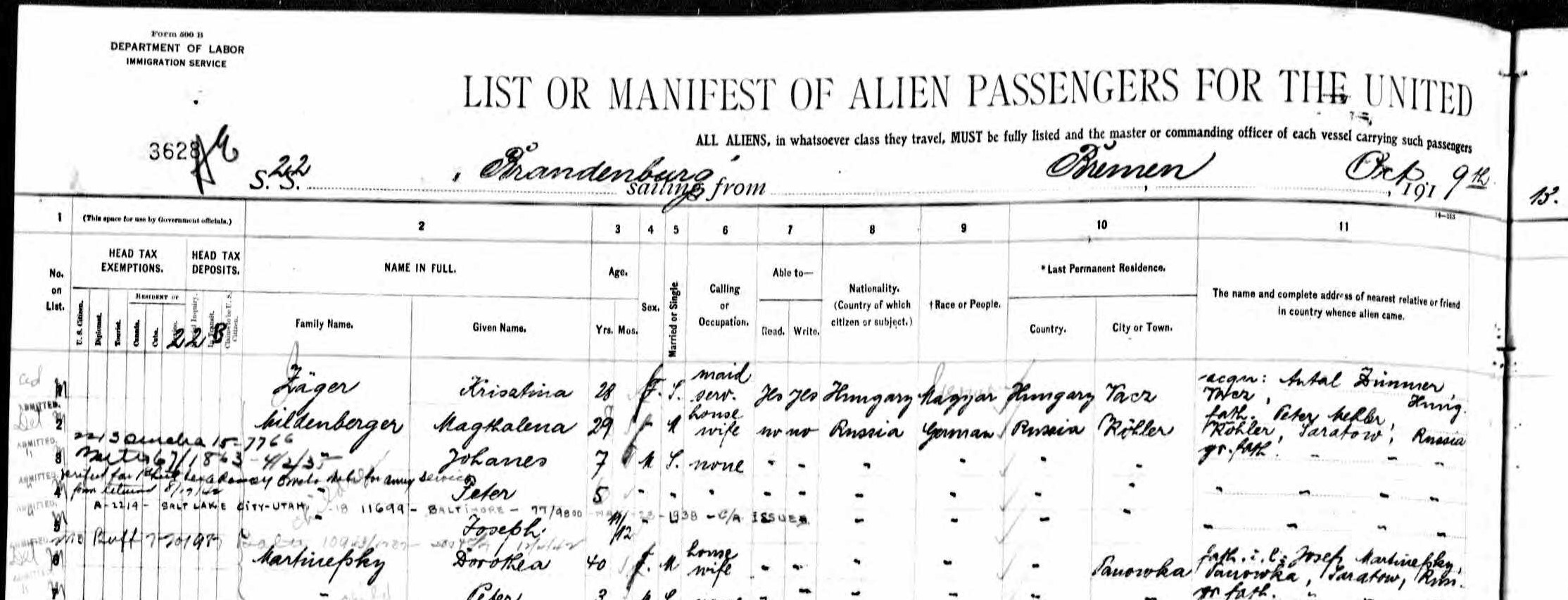
Magthalena
Mildenberger and
children
Arrival date: Oct 1913,
S.S. Brandenburg,
from Bremen, Germany
to Baltimore, Maryland
Source: The National Archives at Washington, D.C.; Washington, D.C.; Records of the US Customs Service, RG36; NAI Number: 2655153; Record Group Title: Records of the Immigration and Naturalization Service, 1787-2004; Record Group Number: 85; Roll Number: 102; Ancestry.com. Baltimore, Passenger Lists, 1820-1964 [database on-line]. Provo, UT, USA: Ancestry.com Operations Inc, 2006. Original data: Selected Passenger and Crew Lists and Manifests. National Archives, Washington, D.C.
Images of naturalization records are shown below as thumbnails. Click on each thumbnail to view a larger version of the record in another tab.
Naturalization papers for Jacob Mahler
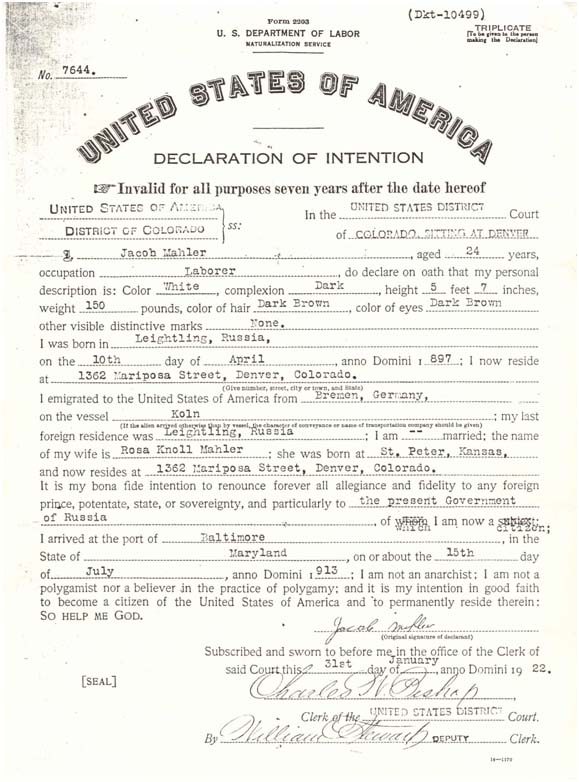
intention, page 1
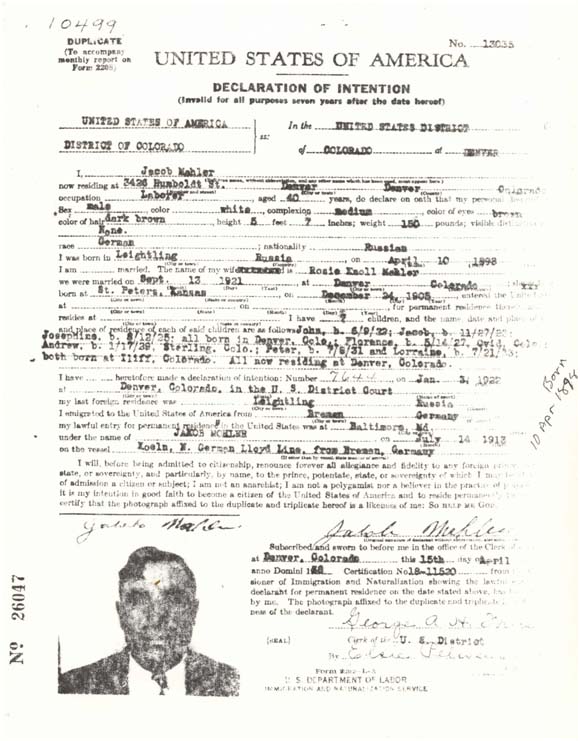
intention, page 2
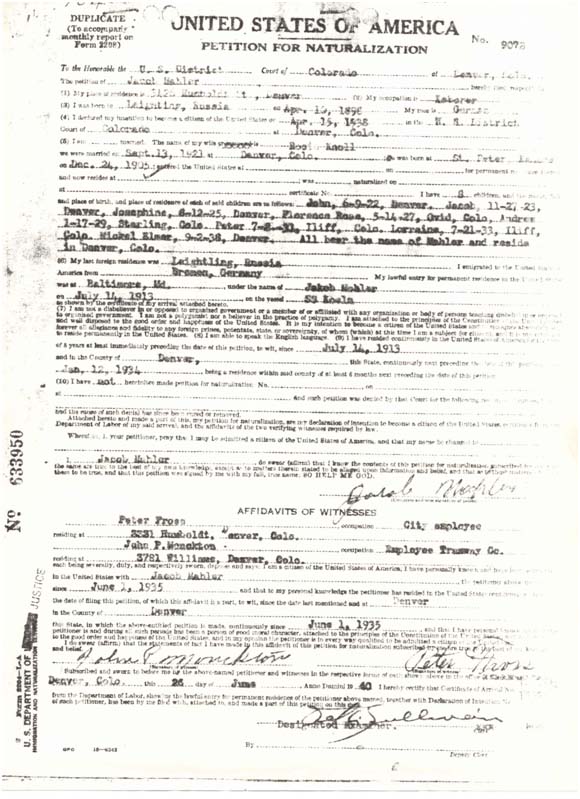
naturalization
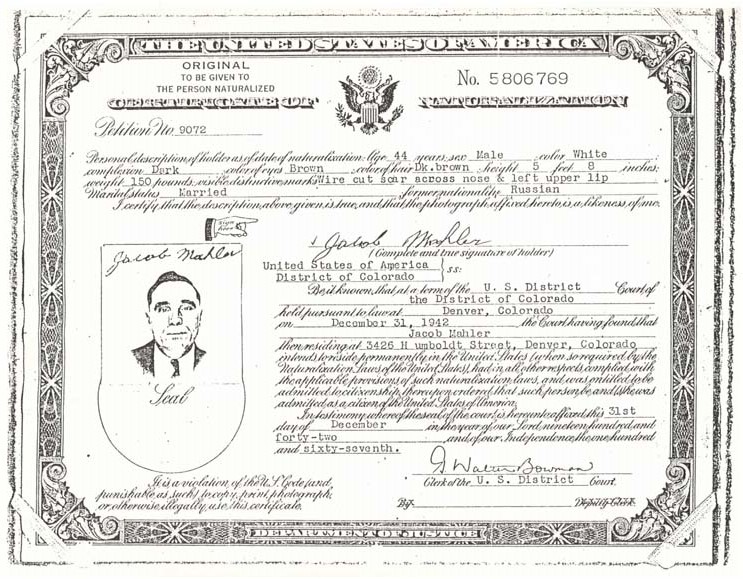
intention
Source: Photocopies of naturalization records from the files of Darryl W. Boyd.
Naturalization papers for Catherine (Mornheiser) (Sweet) Mahlar
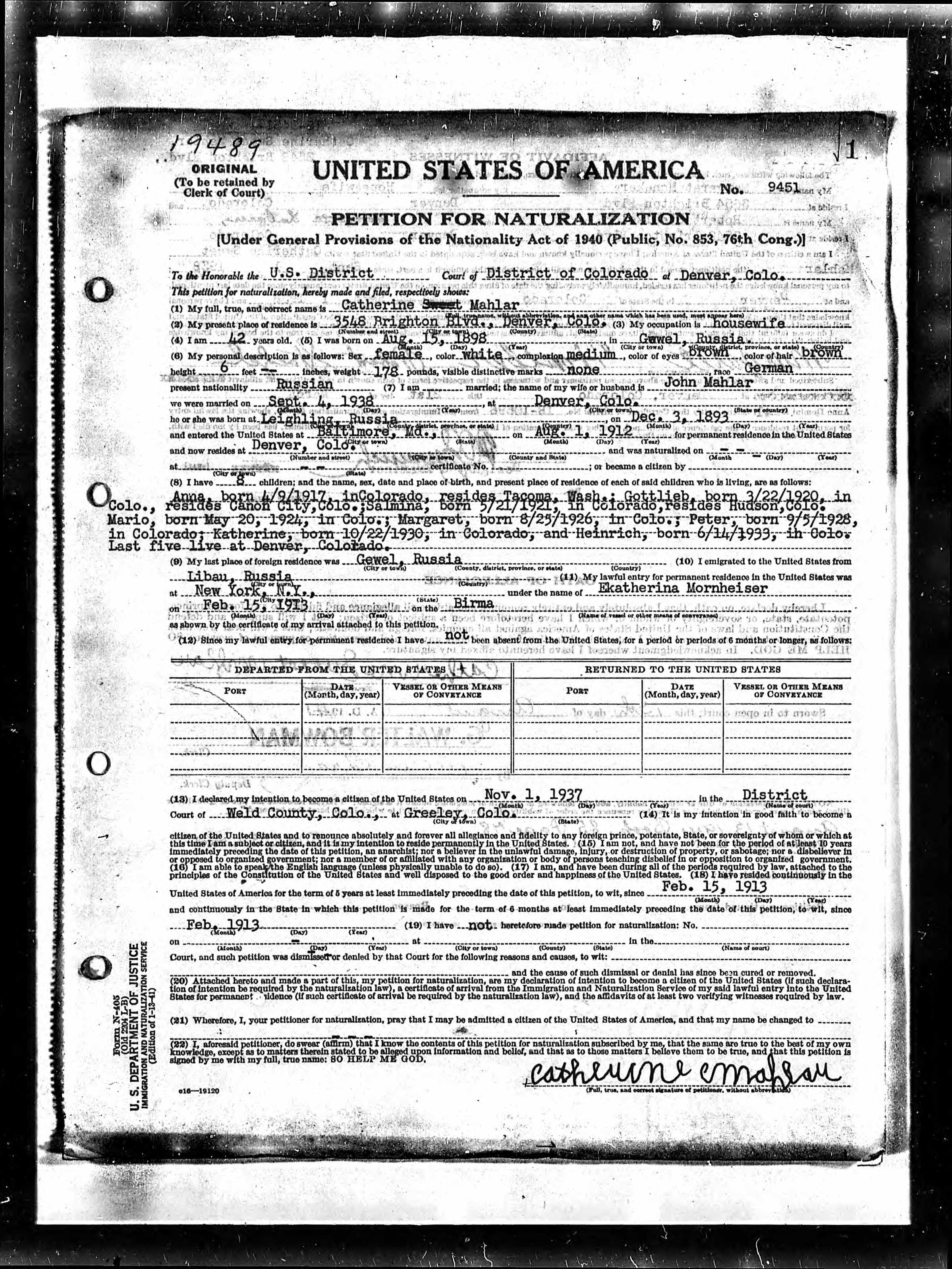
naturalization
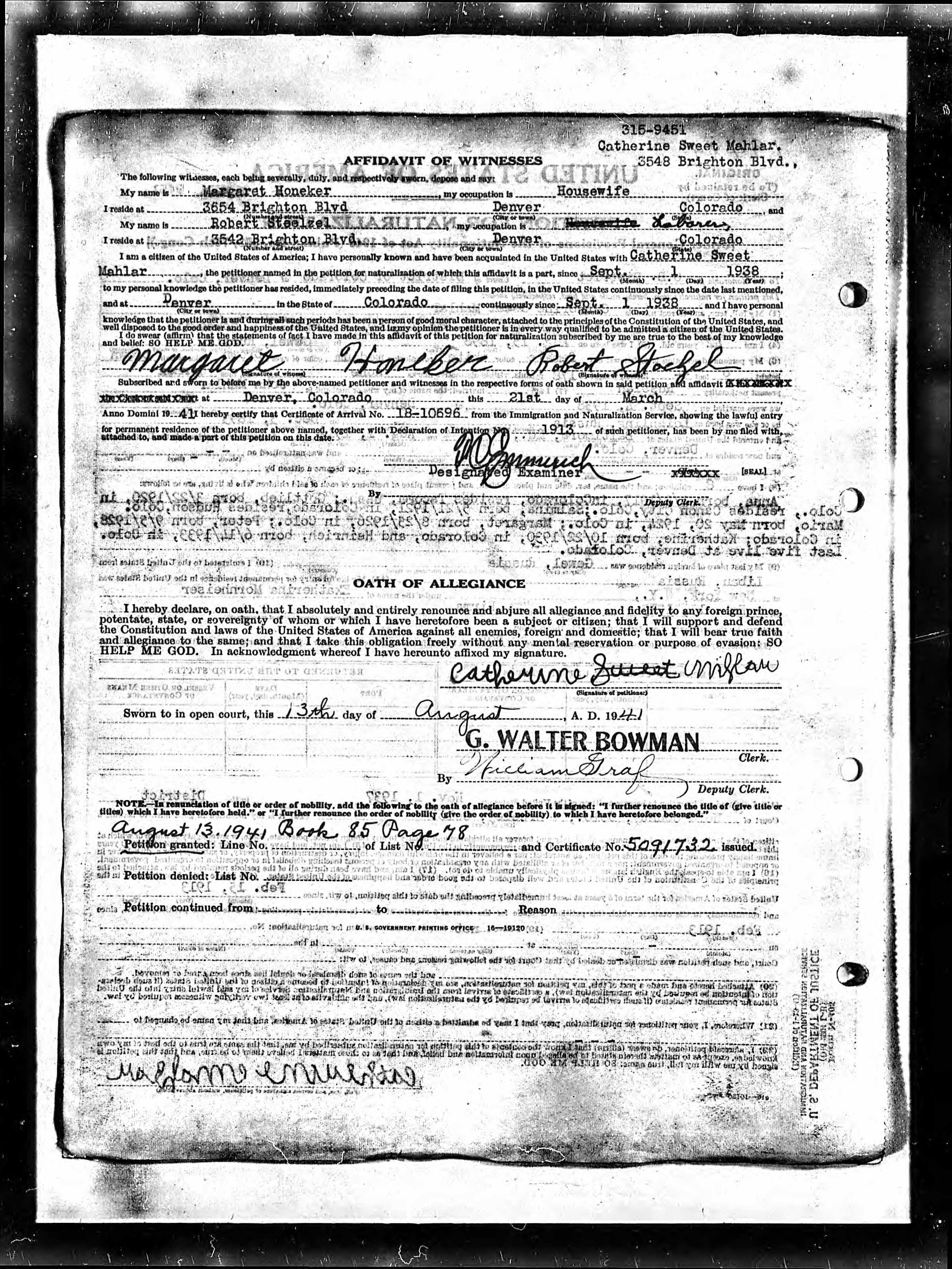
naturalization,
Oath of allegiance
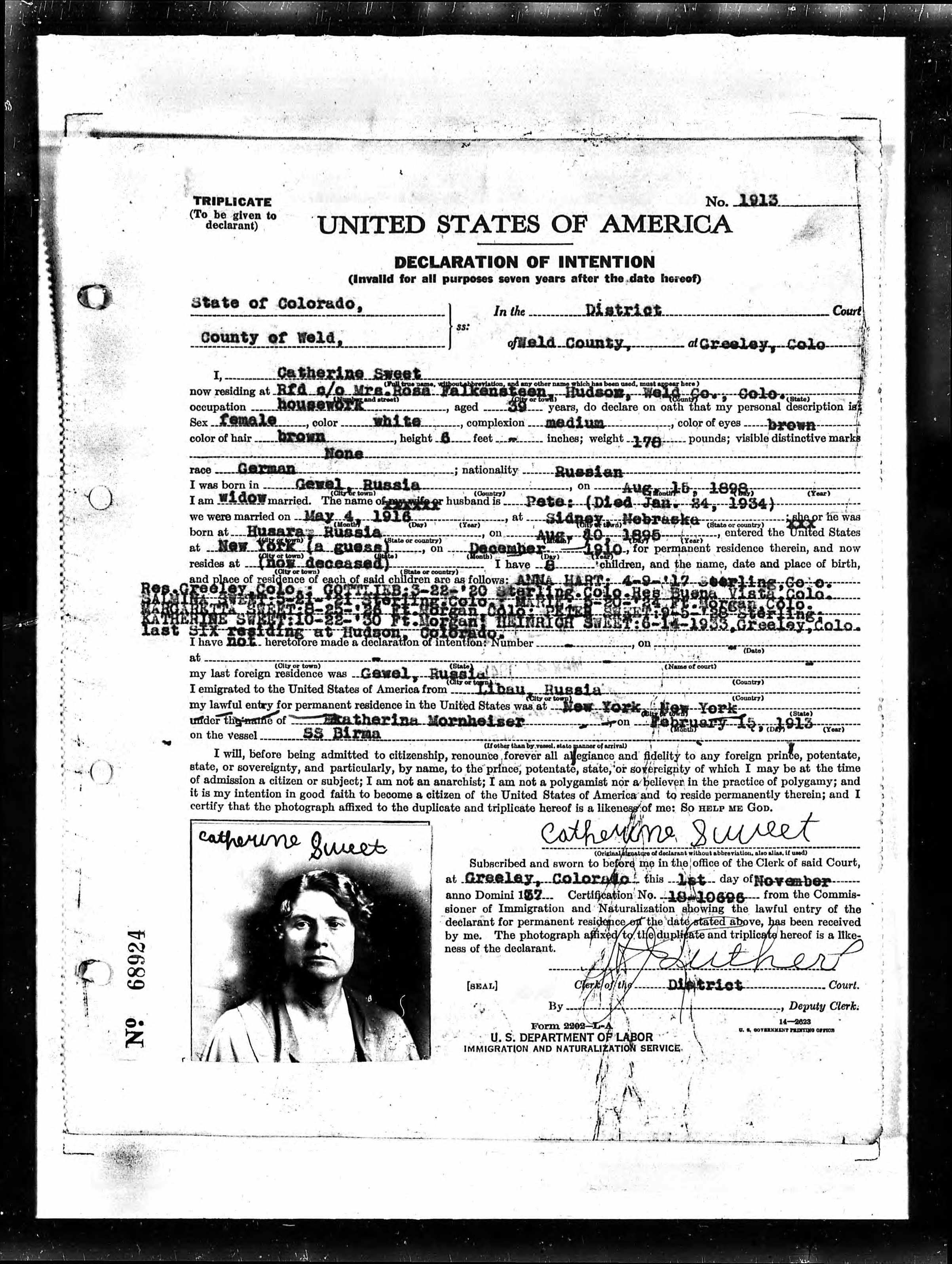
intention
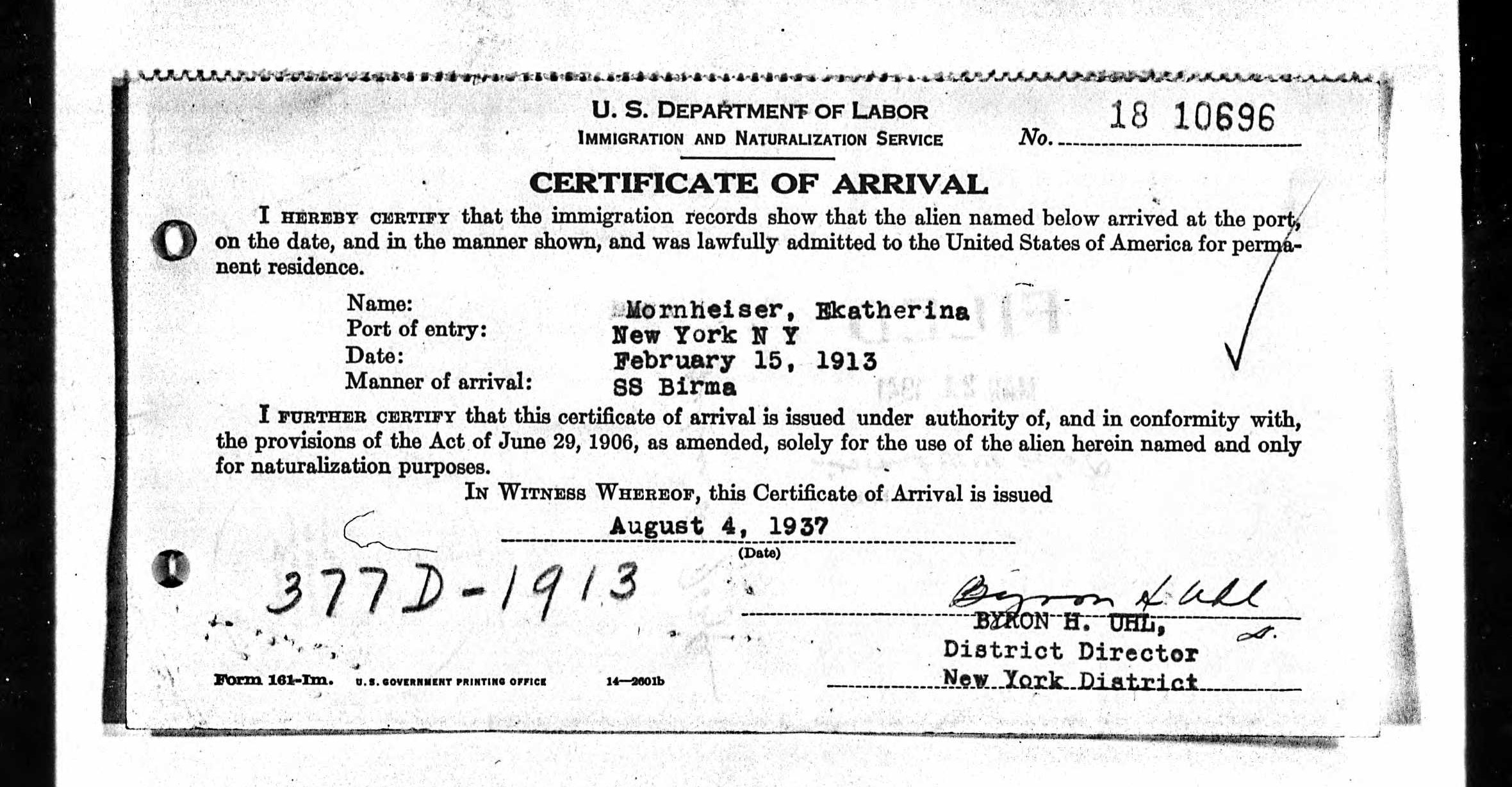
arrival
Source: The National Archives, Washington, D.C.; Washington, DC; Naturalization Records, Colorado, 1876-1990; ARC Title: Naturalization Records Created by the U.S. District Court in Colorado, 1877-1952; NAI Number: M1192; Record Group Title: Records of District Courts of the United States, 1685-2009; Record Group Number: 21; Description: (Roll 54) Vol 38; March 21-November 26, 1941; 9451-9750, Ancestry.com. Colorado, U.S., State and Federal Naturalization Records, 1868-1990 [database on-line]. Lehi, UT, USA: Ancestry.com Operations, Inc., 2016. Original data: Naturalization Records. National Archives at Denver, Broomfield, Colorado.
Copies of military records are shown below as thumbnails. Click on each thumbnail to view a larger version of the record in another tab.
World War II Draft Cards
Source: The National Archives at St. Louis; St. Louis, Missouri; World War II Draft Cards (Fourth Registration) for the State of Colorado; Record Group Title: Records of the Selective Service System; Record Group Number: 147; Box or Roll Number: 093. Ancestry.com. U.S., World War II Draft Registration Cards, 1942 [database on-line]. Lehi, UT, USA: Ancestry.com Operations, Inc., 2010. Original data: United States, Selective Service System. Selective Service Registration Cards, World War II: Fourth Registration. Records of the Selective Service System, Record Group Number 147. National Archives and Records Administration. Full Source Citation.
Copies of census records are shown below as thumbnails. Click on each thumbnail to view a larger version of the record in another tab.
1920
Baltimore (Ward 24), Maryland

Mildenberg;
Year: 1920;
Census Place:
Baltimore Ward 24,
Baltimore (Independent
City), Maryland;
Roll: T625_668;
Page: 19B;
Enumeration District:
396
Source: Fourteenth Census of the United States, 1920. (NARA microfilm publication T625, 2076 rolls). Records of the Bureau of the Census, Record Group 29. National Archives, Washington, D.C.
1930
Sedgwick, Sedgwick, Colorado

Mildenberger;
Year: 1930;
Census Place:
Sedgwick, Sedgwick,
Colorado;
Page: 3A;
Enumeration District:
0007;
FHL microfilm: 2339985

Mildenberger,
continued
Precinct 3, Logan county, Colorado

Year: 1930;
Census Place:
Precinct 3, Logan, Colorado;
Page: 7A;
Enumeration District: 0004;
FHL microfilm: 2339981.
District: 0004;
Description: PRECINCT 3,
ILIFF, EXCLUDING ILIFF TOWN
North Fort Morgan, Morgan, Colorado

Year: 1930;
Census Place: North
Fort Morgan, Morgan,
Colorado;
Page: 3A;
Enumeration District: 0004;
FHL microfilm: 2339981
Source: United States of America, Bureau of the Census. Fifteenth Census of the United States, 1930. Washington, D.C.: National Archives and Records Administration, 1930. T626, 2,667 rolls.
1940
Sedgwick county, Colorado

Mildenberger;
Year: 1940;
Census Place:
Sedgwick, Colorado;
Roll: m-t0627-00480;
Page: 5B;
Enumeration District:
58-5
Denver, Denver, Colorado

Roll: m-t0627-03084;
Page: 10B;
Enumeration District: 35-30

questions for
Michael E. Mahler

Street: Brighton Blvd.
Year: 1940;
Census Place: Denver,
Denver, Colorado;
Roll: m-t0627-00493;
Page: 2B;
Enumeration District:
16-282
Source: United States of America, Bureau of the Census. Sixteenth Census of the United States, 1940. Washington, D.C.: National Archives and Records Administration, 1940. T627, 4,643 rolls.
1950
Ovid, Sedgwick, Colorado

Mildenberger;
Record Group Number: 29;
Residence Date: 1950;
Home in 1950: Ovid,
Sedgwick, Colorado;
Roll: 1949;
Sheet Number: 77;
Enumeration District: 58-5
Denver, Denver, Colorado
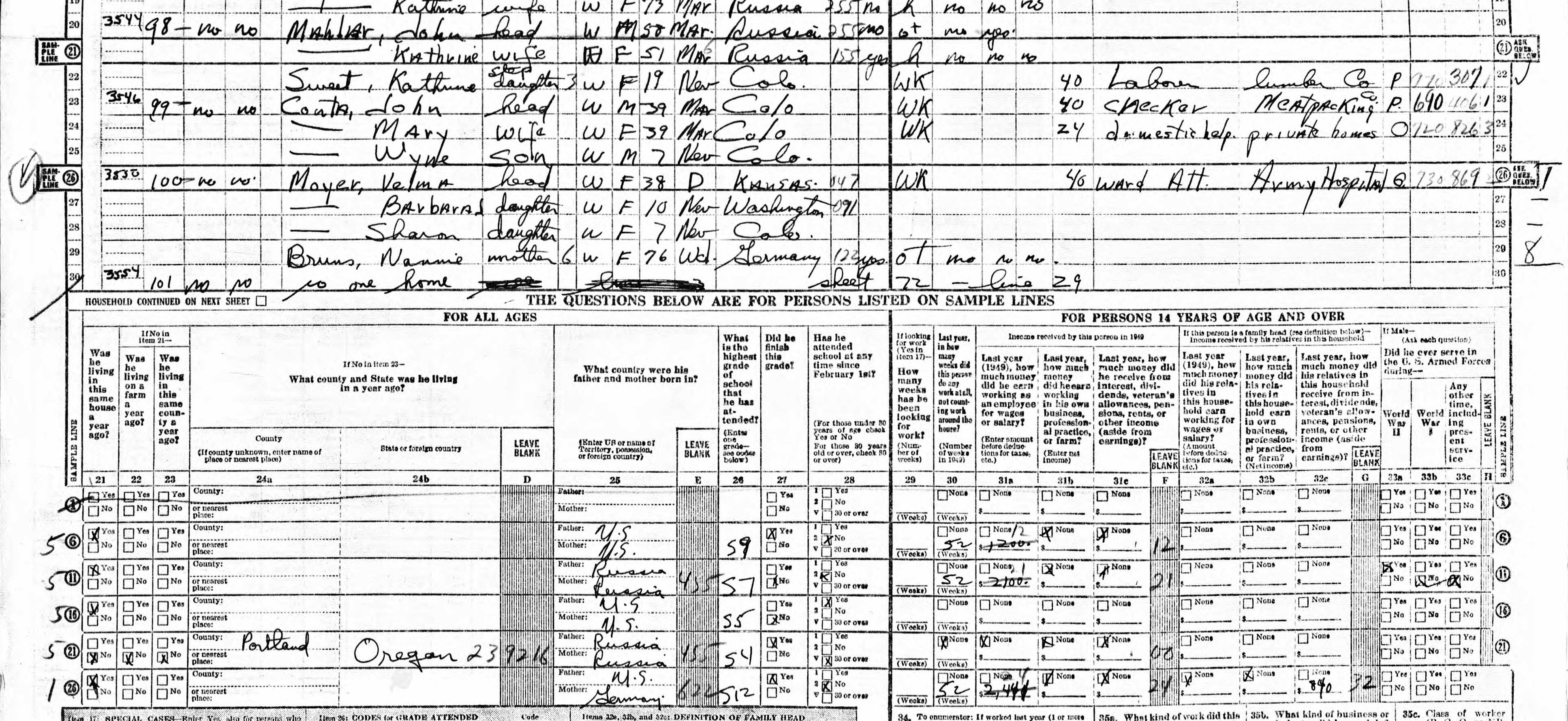
Record Group Number: 29;
Residence Date: 1950;
Home in 1950: Denver,
Denver, Colorado;
Roll: 2186;
Sheet Number: 10;
Enumeration District: 16-539
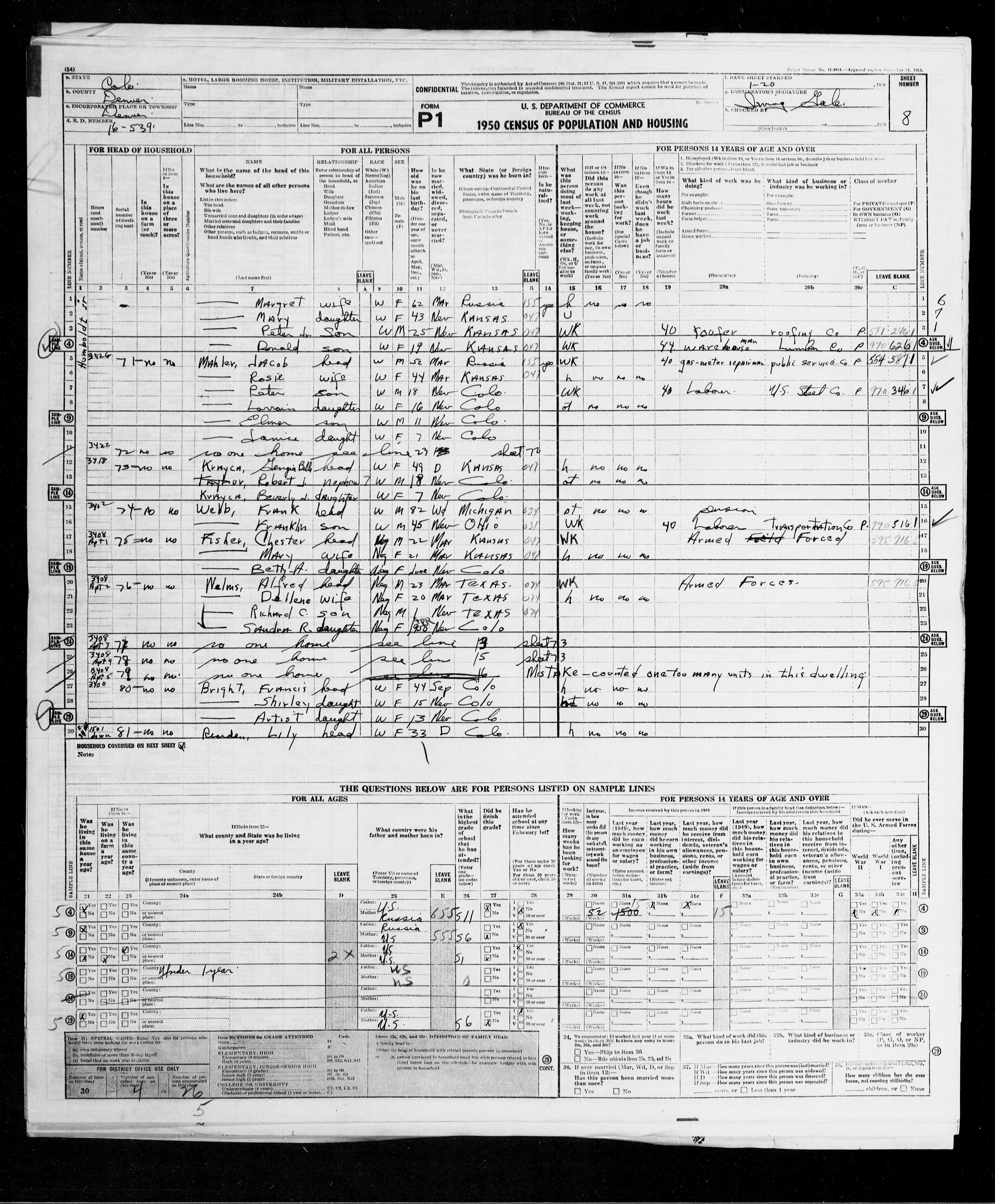
Record Group Number: 29;
Residence Date: 1950;
Home in 1950: Denver,
Denver, Colorado;
Roll: 2186;
Sheet Number: 8;
Enumeration District: 16-539
Source: Department of Commerce. Bureau of the Census. 1913-1/1/1972. Population Schedules for the 1950 Census, 1950 - 1950. Washington, DC: National Archives at Washington, DC. Population Schedules for the 1950 Census, 1950 - 1950. NAID: 43290879. Records of the Bureau of the Census, 1790 - 2007, Record Group 29. National Archives at Washington, DC., Washington, DC.
Items below were found in the files of Florence Mahler Boyd, daughter of Jacob John Mahler.
Copies of items are shown below as thumbnails. Click on each thumbnail to view a larger version of the item in another tab.
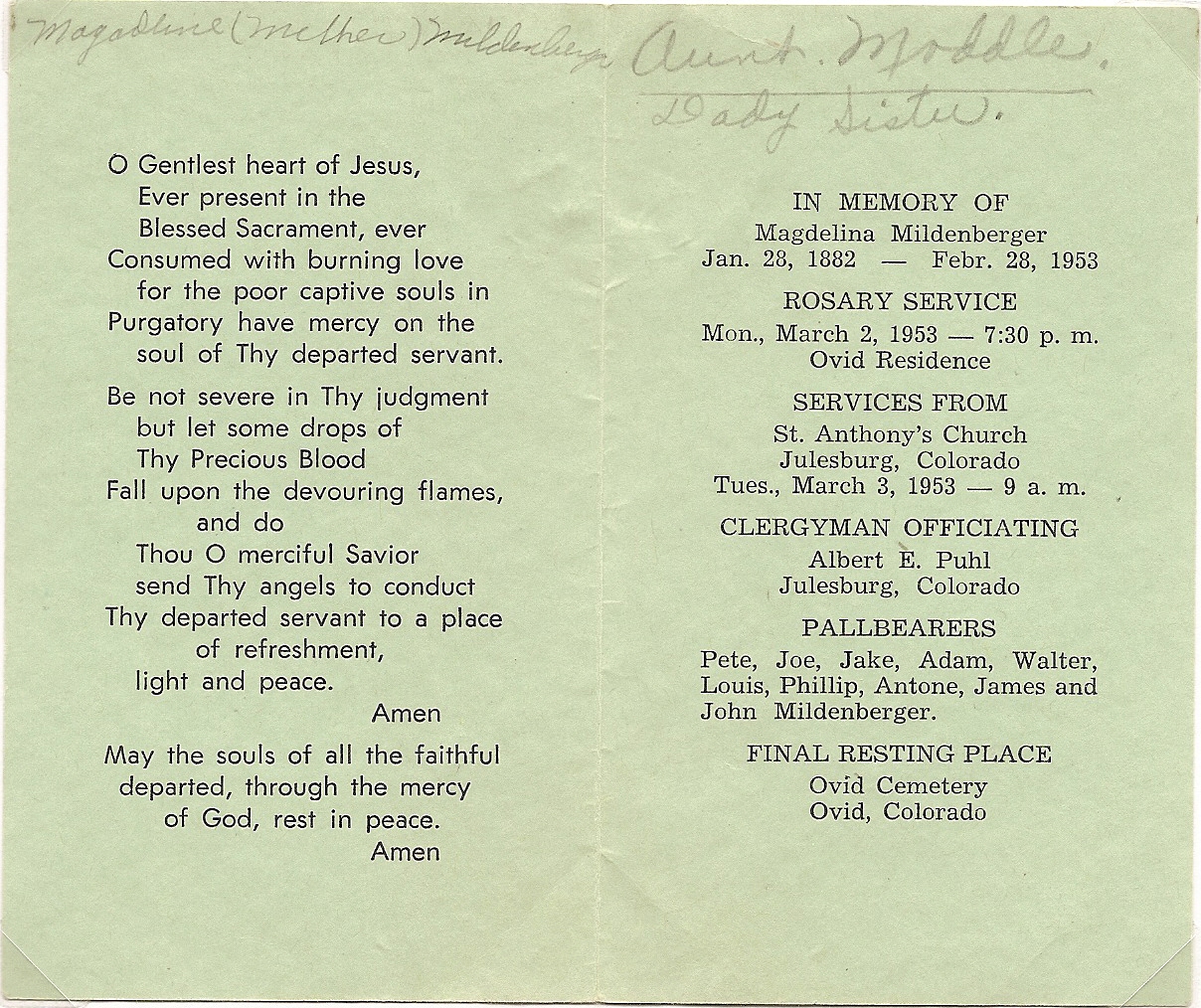
Magdalina
Mildenberger
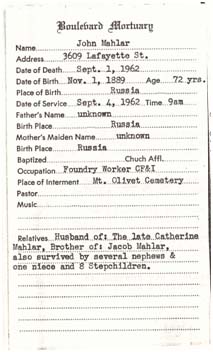
John Mahler
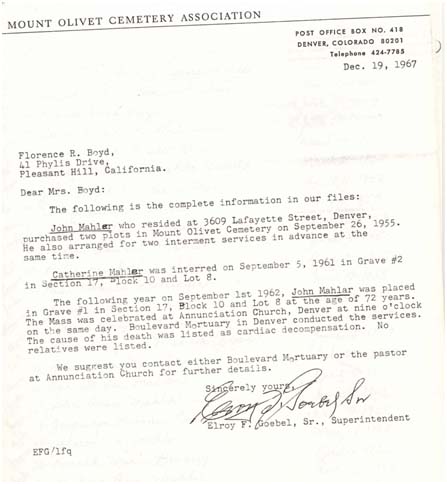
burials of John and
Catherine Mahler
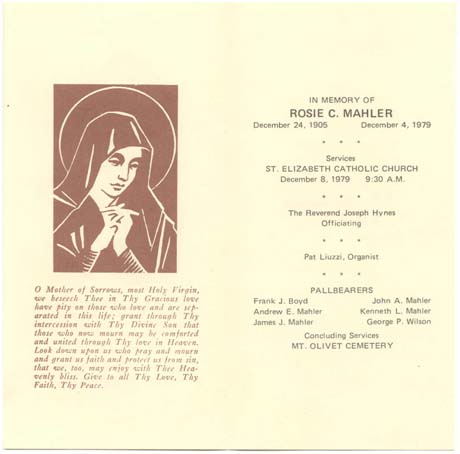
Rosie C. Mahler
Images of the death certificates are shown below as thumbnails. Click on each of the thumbnails to view a larger version of the certificates in another tab.
Colorado Death Certificates
Source: Photocopies of death certificates from the files of Darryl W. Boyd.
Photos are shown below as thumbnails. Click on each thumbnail to view a larger version of the photo in another tab.
Ovid Cemetery, Ovid, Sedgwick, Colorado
Mount Olivet Cemetery, Wheat Ridge, Jefferson, Colorado
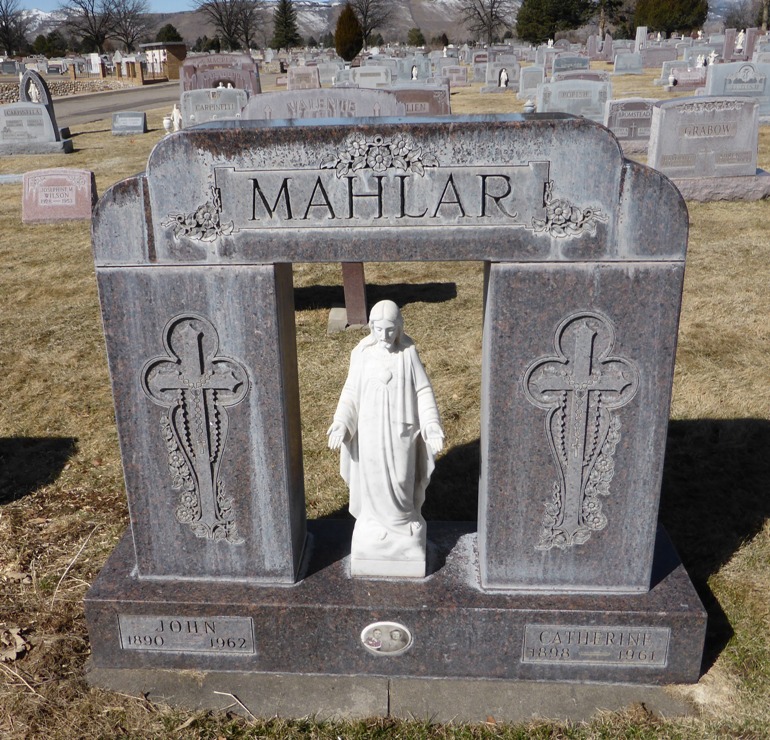
Mahlar
Photo credit: VDR,
findagrave.com
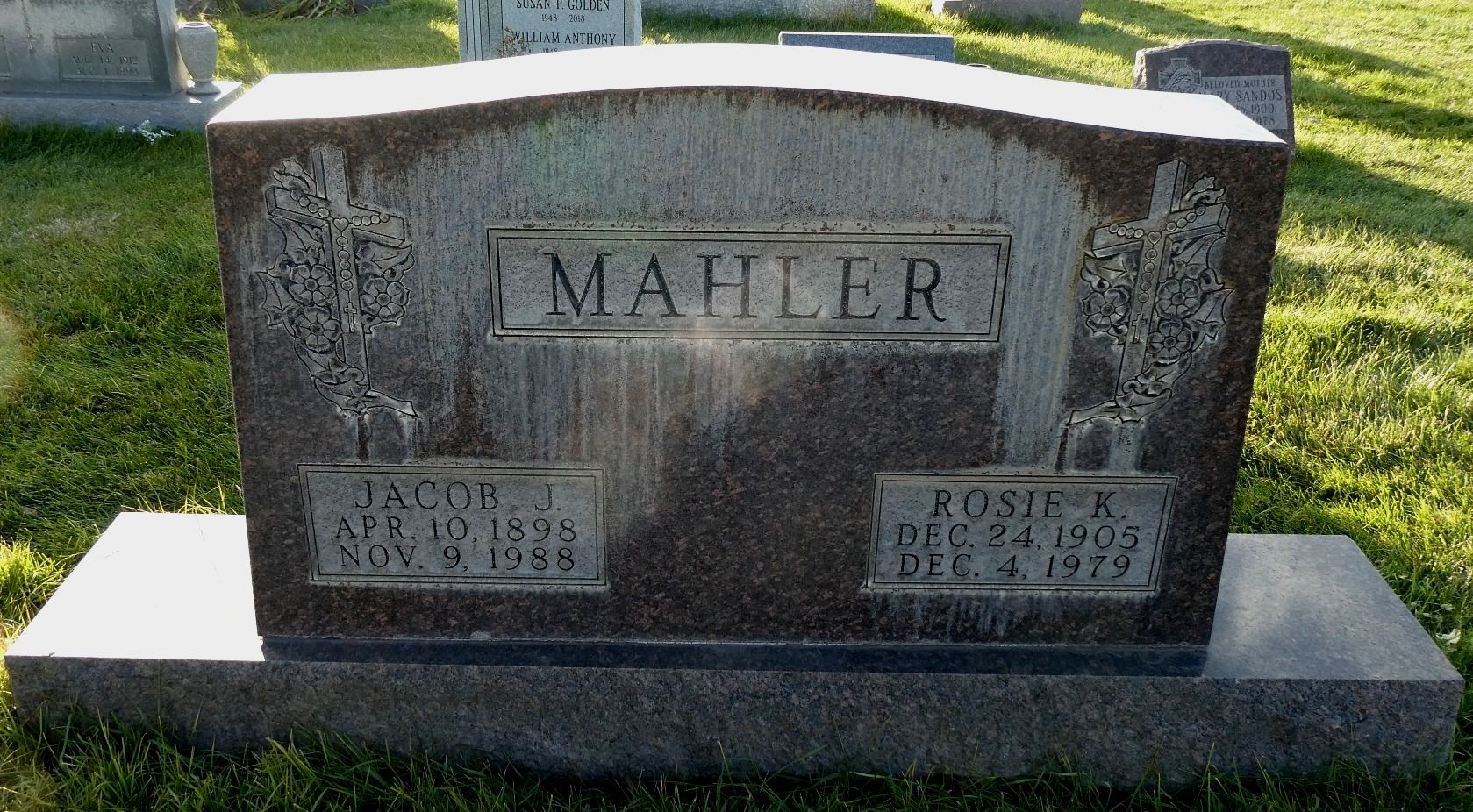
K. Mahler
Photo credit: VDR,
findagrave.com
Return: Home > Ancestry of Florence Rose Mahler > Mahler Family Tree
Author: Michelle A. Boyd
Email
Last updated 31 July 2022
